#kabul (city/town/village)
Text
In Afghanistan, a "Tajik", is typically defined as any primarily Dari-speaking Sunni Muslim who refer to themselves by the region, province, city, town, or village that they are from;[41] such as Badakhshi, Baghlani, Mazari, Panjsheri, Kabuli, Herati, Kohistani, etc.[41][42][43] Although in the past, some non-Pashto speaking tribes were identified as Tajik, for example, the Furmuli.[44][45] By this definition, according to the World Factbook, Tajiks make up about 25–27% of Afghanistan's population,[46][47] but according to other sources, they form 37–39% of the population.[48] Other sources however, for example the Encyclopædia Britannica, state that they constitute about 12–20% of the population,[49][50] which is mostly excluding Persianized ethnic groups like some Pashtuns, Uzbeks, Qizilbash, Aimaqs etc. who, especially in large urban areas like Kabul or Herat, assimiliated into the respective local culture.[51][52][53] Tajiks (or Farsiwans respectively) are predominant in four of the largest cities in Afghanistan (Kabul, Mazar-e Sharif, Herat, and Ghazni) and make up the qualified majority in the northern and western provinces of Badakhshan and Panjshir while making up significant portions of the population in Balkh, Takhar, Kabul, Parwan, Kapisa, Baghlan, Badghis and Herat.
0 notes
Text
Joshua 19: God Sets The Allotments For Simeon And The Other Tribes Of Israel
1 The second lot came out for the tribe of Simeon according to its clans. Their inheritance lay within the territory of Judah.
2 It included:
Beersheba (or Sheba), Moladah,
3 Hazar Shual, Balah, Ezem,
4 Eltolad, Bethul, Hormah,
5 Ziklag, Beth Markaboth, Hazar Susah,
6 Beth Lebaoth and Sharuhen—thirteen towns and their villages;
7 Ain, Rimmon, Ether and Ashan—four towns and their villages—
8 and all the villages around these towns as far as Baalath Beer (Ramah in the Negev).
This was the inheritance of the tribe of the Simeonites, according to its clans.
9 The inheritance of the Simeonites was taken from the share of Judah, because Judah’s portion was more than they needed. So the Simeonites received their inheritance within the territory of Judah.
Allotment for Zebulun
10 The third lot came up for Zebulun according to its clans:
The boundary of their inheritance went as far as Sarid.
11 Going west it ran to Maralah, touched Dabbesheth, and extended to the ravine near Jokneam.
12 It turned east from Sarid toward the sunrise to the territory of Kisloth Tabor and went on to Daberath and up to Japhia.
13 Then it continued eastward to Gath Hepher and Eth Kazin; it came out at Rimmon and turned toward Neah.
14 There the boundary went around on the north to Hannathon and ended at the Valley of Iphtah El.
15 Included were Kattath, Nahalal, Shimron, Idalah and Bethlehem. There were twelve towns and their villages.
16 These towns and their villages were the inheritance of Zebulun, according to its clans.
Allotment for Issachar
17 The fourth lot came out for Issachar according to its clans.
18 Their territory included:
Jezreel, Kesulloth, Shunem,
19 Hapharaim, Shion, Anaharath,
20 Rabbith, Kishion, Ebez,
21 Remeth, En Gannim, En Haddah and Beth Pazzez.
22 The boundary touched Tabor, Shahazumah and Beth Shemesh, and ended at the Jordan. There were sixteen towns and their villages.
23 These towns and their villages were the inheritance of the tribe of Issachar, according to its clans.
Allotment for Asher
24 The fifth lot came out for the tribe of Asher according to its clans.
25 Their territory included:
Helkath, Hali, Beten, Akshaph,
26 Allammelek, Amad and Mishal. On the west the boundary touched Carmel and Shihor Libnath.
27 It then turned east toward Beth Dagon, touched Zebulun and the Valley of Iphtah El, and went north to Beth Emek and Neiel, passing Kabul on the left.
28 It went to Abdon, Rehob, Hammon and Kanah, as far as Greater Sidon.
29 The boundary then turned back toward Ramah and went to the fortified city of Tyre, turned toward Hosah and came out at the Mediterranean Sea in the region of Akzib,
30 Ummah, Aphek and Rehob. There were twenty-two towns and their villages.
31 These towns and their villages were the inheritance of the tribe of Asher, according to its clans.
Allotment for Naphtali
32 The sixth lot came out for Naphtali according to its clans:
33 Their boundary went from Heleph and the large tree in Zaanannim, passing Adami Nekeb and Jabneel to Lakkum and ending at the Jordan.
34 The boundary ran west through Aznoth Tabor and came out at Hukkok. It touched Zebulun on the south, Asher on the west and the Jordan on the east.
35 The fortified towns were Ziddim, Zer, Hammath, Rakkath, Kinnereth,
36 Adamah, Ramah, Hazor,
37 Kedesh, Edrei, En Hazor,
38 Iron, Migdal El, Horem, Beth Anath and Beth Shemesh. There were nineteen towns and their villages.
39 These towns and their villages were the inheritance of the tribe of Naphtali, according to its clans.
Allotment for Dan
40 The seventh lot came out for the tribe of Dan according to its clans.
41 The territory of their inheritance included:
Zorah, Eshtaol, Ir Shemesh,
42 Shaalabbin, Aijalon, Ithlah,
43 Elon, Timnah, Ekron,
44 Eltekeh, Gibbethon, Baalath,
45 Jehud, Bene Berak, Gath Rimmon,
46 Me Jarkon and Rakkon, with the area facing Joppa.
47 (When the territory of the Danites was lost to them, they went up and attacked Leshem, took it, put it to the sword and occupied it. They settled in Leshem and named it Dan after their ancestor.)
48 These towns and their villages were the inheritance of the tribe of Dan, according to its clans.
Allotment for Joshua
49 When they had finished dividing the land into its allotted portions, the Israelites gave Joshua son of Nun an inheritance among them,
50 as the Lord had commanded. They gave him the town he asked for—Timnath Serah in the hill country of Ephraim. And he built up the town and settled there.
51 These are the territories that Eleazar the priest, Joshua son of Nun and the heads of the tribal clans of Israel assigned by lot at Shiloh in the presence of the Lord at the entrance to the tent of meeting. And so they finished dividing the land.
#Lord God Jehovah#Holy Bible#Joshua ch.19#Joshua#Eleazar#Israelites#Allotments#Tribes#Inheritances#Jacob#Simeon#Zebulun#Isaachar#Asher#Naphtali#Dan#Divide#Promise Land#Clans#Only Him
1 note
·
View note
Text
instagram
Episode 133: The Haunting of OP Rock and The Ghosts of the War in Afghanistan
Image 01: WELCOME TO THE PREMIERE!!!!
Image 02: In the village of Qalat, a castle fortress called the Bala Haizar has towered over the town since Alexander the Great himself ordered it to be built 2,000 years ago.
Image 03: (top) Afghan children play on the remains of an old destroyed Soviet Union tank in Jalalabad 2012. (Noorullah Shirzada/AFP/Getty Images) & (bottom) the remains of two 1980s Soviet armored personnel carriers outside the Amir Agha villages
Image 04: Tutankhamun's death mask features lapis lazuli from the Sar-i-sang mines, which are the oldest mines in the world. Around 2500 BC, lapis lazuli was exported from Afghanistan to Iraq for the harps buried with the kings of the ancient city of Ur
Image 05: Map of the Silk Road, which passed through Afghanistan
Image 06: Ahmad Zahir aka “The Afghan Elvis” music video - Don’t even try to deny this rizz
Image 07: OP Rock, photo 1 & OP Rock, photo 2
Image 08: THE GOLDEN ERA - Picture taken in 1962 at the Faculty of Medicine in Kabul of two Afghan medicine students listening to their professor (at right) as they examine a plaster cast showing a part of a human body vs. Afghan girls hold illegal protest to demand the right to education in a private home in Kabul, Afghanistan, Tuesday, Aug. 2, 2022. (AP Photo/Ebrahim Noroozi)
Image 09: Afghanistan’s modern provinces
Image 10: Headline from The Guardian in 2009 (Top) Farmer Mohammed Yaqoob in a poppy field in Musa Qala, Helmand province. (Bottom) Photograph: Shah Meer Baloch/The Guardian
#The Haunting of OP Rock and The Ghosts of the War in Afghanistan#Let's Get Haunted#Bala Haizar#Jalalabad#Tutankhamun's death mask#Instagram
1 note
·
View note
Text
Stop Doing This In Kabul
Stop Doing This In Kabul
BEST ACCOMMODATION DEALS IN KABUL HERE
GET TO KNOW THE CITY
Kabul is the capital and largest city in Afghanistan. It has a population of around 4.6 million people and is divided into 22 districts. Its rapid urbanization makes it the world’s 75th largest city.
Kabul is located in a valley between the Hindu Kush Mountains and the Kabul River, making it one of the world’s highest capital cities.…
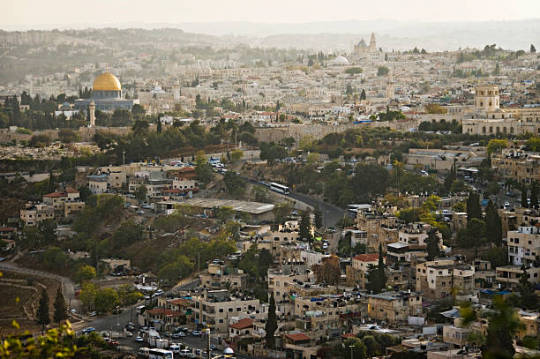
View On WordPress
#afganistan women protest in kabul#afghanistan kabul news#gurdwara attacked in kabul#gurdwara attacked in kabul afghanistan#gurudwara attacked in kabul#isis suicide bombs at kabul#kabul#kabul (city/town/village)#kabul airport#kabul airport bombings#kabul airport bombs#kabul airport news#kabul airport today#kabul news#kabul sikh attack#old kabul#suicide bomber in kabul#taliban in kabul#taliban kabul#taliban kabul news
0 notes
Text
IN PICTURES | REMOTE PLACES | AFGHANISTAN
A New Road To An Inaccessible Land

— By Simon Urwin | 2nd July 2021
Once an isolated region barely touched by the hands of time, Afghanistan's Wakhan Corridor stands on the brink of great change with the building of a new road linking it with China.

On the Cusp of Six Borders
Bordered by China, Iran, Pakistan, Tajikistan, Turkmenistan and Uzbekistan, the Islamic Republic of Afghanistan lies at the very heart of Asia. Home to more than 32 million people, a quarter of its population lives in large urban centres such as Mazar-e Sharif (pictured), located 320km north-west of the capital Kabul. The fourth-largest city in the country, its centrepiece is the Shrine of Hazrit Ali – a masterpiece of Islamic architecture, which, according to local legend, is the burial place of Ali, the cousin and son-in-law of the Prophet Muhammad. The shrine is also renowned for its flocks of white doves. Locals believe that a small speck of another colour on a bird's feathers will instantly turn pure white when in the sacred building's vicinity. (Credit: Simon Urwin)

A Remote Corridor
Some 600km to the east of Mazar-e Sharif, the Wakhan Corridor (pictured) is a world apart from the rest of the country, both culturally and geographically. This 350km-long panhandle, in the region of Badakhshan, sits at the convergence of three of the world's major mountain ranges: the Hindu Kush, the Karakoram and the Pamirs – known as the Pamir Knot. "This is about as far away from the noise, the traffic and the muezzin's call to prayer of urban Afghanistan as you can get," said James Willcox of untamedborders.com, one of just a few adventure travel companies in the world that arranges trips to the region. "It is barely habited and hard to get to; few people even know of its existence. It's undoubtedly one of the remotest, and most beautiful places in the whole of Asia." (Credit: Simon Urwin)

A Rural Life
Scattered along the Wakhan Corridor are small rural settlements like Khandud (pictured), their simple houses made of stone, mud and timber. Some of the larger villages are connected by a single dirt track, often made impassible by the waters of the River Panj. "Very few people have their own car in the Wakhan, but we have community transport – as well as donkeys, and our feet, of course," said Azim Ziahee, a resident of the market town of Ishkashim, located 80km away at the Corridor's western end. "The Wakhan still remains very cut-off though. Some villages are more than four days' walk to Ishkashim. The nearest big town from here – Dushanbe, the capital of Tajikistan – is a three-day drive. The isolation keeps the corridor like a time capsule. We look over to the border towards Tajikistan, with its electricity, paved roads and mobile phone signal, and say that it's like looking 100 years into the future." (Credit: Simon Urwin)
Home of the Wakhi
For more than 2,500 years, the Wakhan Corridor has been the homeland of the Wakhi people and is now home to a population of around 12,000. While the majority of Afghans are conservative Sunni Muslims, the Wakhi are Ismailis, who belong to the Shia branch of Islam. Here, women do not wear the burqa, and there are no mosques; instead, the Wakhi visit jamatkhanas (houses of prayer that also serve as community halls for conducting village business). "Ismailis are considered less strict than Sunnis," said Willcox. "For example, in the Wakhan, a Western male visitor can ask permission to take a woman's photograph without causing offence. Elsewhere in Afghanistan that would be unthinkable. (Credit: Simon Urwin)

The Rhythm of Life
The Wakhi are farmers, cultivating wheat, barley, peas, potatoes, and apple and apricot trees in the semi-arid conditions of the corridor; their fields fed by melt water from mountain glaciers. Wealthier families have sheep and goats along with a few camels, yaks, horses and donkeys. "Every June, the Wakhi take their livestock to summer pastures, up as high as 4,500m, where the animals grow fat on the rich grass," said Ziahee. "The migration is called the 'kuch'. We also have the 'Chinir', which is our festival in early August to celebrate the start of the barley harvest. In the towns of Afghanistan, the five daily prayers form the structure of the day, but here, we feel a great connection to the land, and whilst we pray daily, the rhythm of life revolves more around the fields, the seasons and nature." (Credit: Simon Urwin)
A Centuries-old Tradition
One of the most distinctive traditions of the Wakhan is the centuries-old game of buzkhasi, sometimes described as rugby on horseback with the body of a goat as a ball. Thought to be an early pre-cursor to polo, buzkashi has no rules and no sides. There is certainly no sense of "fair play", as competitors will punch and whip each other in an effort to steal the goat, and broken bones are not uncommon. "The Wakhi villages love to play each other, especially at Nawruz, which is the Afghan New Year," Ziahee explained. "But here it's different to other parts of Afghanistan. Elsewhere, buzkashi is more political – put on to show the power of the elite, or by a politician as a way to win votes. Here, it is all about the competition and the community. It is one of many things that makes the Wakhan so unique." (Credit: Simon Urwin)
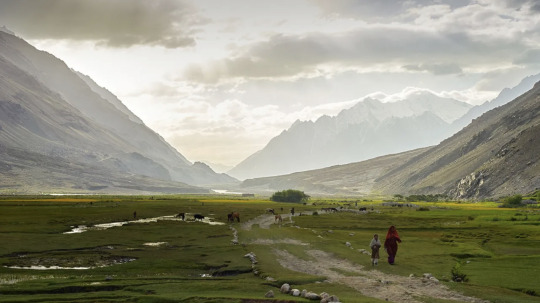
Untouched By Tourism
While Afghanistan's security situation dictates that much of the country is off-limits to foreigners, the corridor's relative safety, alongside its pristine mountain scenery and well-preserved Wakhi culture, has seen its appeal with off-the-beaten-trackers grow markedly in recent years. "At first there were only a handful of visitors," said Ade Summers, an adventure guide who has led nine expeditions to the Wakhan. "Over a decade, that's slowly grown to up to 600 people a year. It's a privilege to visit somewhere so untouched by mainstream tourism, where you can engage with people who still relish their traditional way of life. As you journey along the Wakhan, not only is it very beautiful, every step you take is like turning the pages of a fascinating history book." (Credit: Simon Urwin)

Part of the Silk Road
For hundreds of years, the Wakhan Corridor was an important route for merchants travelling along the Silk Road, the trade route that emerged in the 1st and 2nd Centuries BCE linking China with the Mediterranean. "Those merchants carried Chinese silk, Persian silver, Roman gold and Afghan lapis lazuli, mined here in the Badakhshan region," said Summers. "We find rock art detailing the road's history, such as petroglyphs of camels walking in single file as a trade caravan." Travellers and pilgrims followed in the merchants' footsteps. "Marco Polo is said to have passed through here on his way to China in the 13th Century, also Alexander the Great. We can still see the remains of historic travellers' shelters known as rabats, as well as ancient Buddhist stupas." (Credit: Simon Urwin)
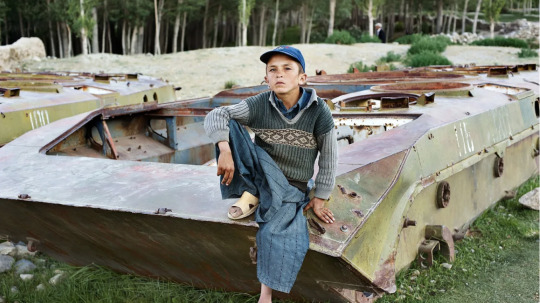
A Strategic Place
In the late 19th Century, the Wakhan Corridor played a key role in the so-called "Great Game" between Great Britain and Russia. "When the Russians and the British were fighting for control of Central Asia, Afghanistan was hugely strategic,", said Willcox. "The Wakhan's current boundaries were formed in 1893 to create a buffer zone to prevent both parties' territories from touching each other – in this case, the British Raj and the Tsarist Russian empire. It eventually turned an old trade route into a cul-de-sac. More recent, history has seen the Wakhan caught up in the Cold War; and now the latest changes in geopolitics will have perhaps an unexpected consequence, with China's Belt and Road Initiative turning it into an important trade route once again." (Credit: Simon Urwin)

New Construction
Until recently, the dirt track from Ishkashim reached only as far as Sarhad-e Broghil in the centre of the Corridor. Onward travel east was only possible by foot or with pack animals. Now though, with Belt and Road construction, the track has been extended by some 75km, as far as the village of Bozai Gumbaz, around three quarters of the way along the Wakhan. "It follows an old trading route that the Kyrgyz nomads take to get to Sarhad from where they live around Chaqmaqtin Lake," said Summers. "The bulldozers have come in, and while they've only constructed something the size of a farmer's track, the potential consequences are much bigger. The Chinese are said to be building the stretch that will eventually connect their border with Bozai Gumbaz, something that will open up the cul-de-sac once more. Ultimately, it will give China great access to the markets of Central Asia and beyond." (Credit: Simon Urwin)

Mixed Emotions
Ziahee says that the people of the Wakhan have mixed feelings about the road's potential impact. "Some things will be good for us," he said. "We will be able to buy goats from China which will be much cheaper than from the market in Ishkashim. We hope to have access to better healthcare, too. At the moment, many of our facilities are very limited. But we worry that the unique Wakhi culture and slow way of life will be changed forever. We love the silence and beautiful nature, but fear that it will be destroyed by traffic pollution. Building a road takes a long time in the mountains, but we think in the next year or so it will be completed. Both the Chinese and Afghan governments want it to happen. Only time will tell what the future holds for us as a result." (Credit: Simon Urwin)
5 notes
·
View notes
Photo




Fighting for Survival: new in fiction
Just Get Home: A Thriller by Bridget Foley
When a devastating earthquake - the Big One - hits Los Angeles, two strangers are brought together by an act of violence and must help each other survive the wrecked city.
Beegie is riding the bus when the quake hits. The teenager was heading back to her unhappy foster home, but then she’s thrown into a broken world. Roads crumble, storefronts shatter and people run wild.
Dessa, a single mom, is enjoying a rare night out when it strikes. Cell towers are down, so without even knowing if her 3-three-year-old daughter is dead or alive, she races to get back across town.
As danger escalates in the chaotic streets, Beegie and Dessa meet by a twist of fate. The two form a fragile partnership, relying on each other in ways they never thought possible, and learn who they really are when there’s only one goal: Just get home.
The Last Exiles by Ann Shin
The Last Exiles is a searing portrait of a young couple in North Korea and their fight for love and freedom
Jin and Suja met and fell in love while studying at university in Pyongyang. She was a young journalist from a prominent family, while he was from a small village of little means. Outside the school, North Korea has fallen under great political upheaval, plunged into chaos and famine. When Jin returns home to find his family starving, their food rations all but gone, he makes a rash decision that will haunt him for the rest of his life.
Meanwhile, miles away, Suja has begun to feel the tenuousness of her privilege when she learns that Jin has disappeared. Risking everything, and defying her family, Suja sets out to find him, embarking on a dangerous journey that leads her into a dark criminal underbelly and will test their love and will to survive.
We Are Watching Eliza Bright by A.E. Osworth
Eliza Bright was living the dream as an elite video game coder at Fancy Dog Games when her private life suddenly became public. But is Eliza Bright a brilliant, self-taught coder bravely calling out the toxic masculinity and chauvinism that pervades her workplace and industry? Or, is Eliza Bright a woman who needs to be destroyed to protect "the sanctity of gaming culture"? It depends on who you ask...
When Eliza reports an incident of workplace harassment that is quickly dismissed, she's forced to take her frustrations to a journalist who blasts her story across the Internet. She's fired and doxed, and becomes a rallying figure for women across America. But she's also enraged the beast that is male gamers on 4Chan and Reddit, whose collective, unreliable voice narrates our story. Soon Eliza is in the cross-hairs of the gaming community, threatened and stalked as they monitor her every move online and across New York City.
As the violent power of an angry male collective descends upon everyone in Eliza's life, it becomes increasingly difficult to know who to trust, even when she's eventually taken in and protected by an under-the-radar Collective known as the Sixsterhood. The violence moves from cyberspace to the real world, as a vicious male super-fan known only as The Ghost is determined to exact his revenge on behalf of men everywhere. We watch alongside the Sixsterhood and subreddit incels as this dramatic cat-and-mouse game plays out to reach its violent and inevitable conclusion.
Sparks Like Stars by Nadia Hashimi
Kabul, 1978: The daughter of a prominent family, Sitara Zamani lives a privileged life in Afghanistan’s thriving cosmopolitan capital. The 1970s are a time of remarkable promise under the leadership of people like Sardar Daoud, Afghanistan’s progressive president, and Sitara’s beloved father, his right-hand man. But the ten-year-old Sitara’s world is shattered when communists stage a coup, assassinating the president and Sitara’s entire family. Only she survives.
Smuggled out of the palace by a guard named Shair, Sitara finds her way to the home of a female American diplomat, who adopts her and raises her in America. In her new country, Sitara takes on a new name—Aryana Shepherd—and throws herself into her studies, eventually becoming a renowned surgeon.
New York, 2008: Thirty years after that fatal night in Kabul, Aryana’s world is rocked again when an elderly patient appears in her examination room—a man she never expected to see again. It is Shair, the soldier who saved her, yet may have murdered her entire family. Seeing him awakens Aryana’s fury and desire for answers—and, perhaps, revenge.
#thrillers#thriller#historical fiction#Historical Reads#adult fiction#book recs#reading recommendations#recommended reading#to read#tbr#currently reading#booklr#reading list#genre reading#library picks
4 notes
·
View notes
Text
2020
What stories was I sleeping on?
So, what stories did I definitely miss before this project? Well, Atlantic Hurricanes and the Belarussian protests, for sure. Here are some of the other news I skipped out on during the year - or my recaps.
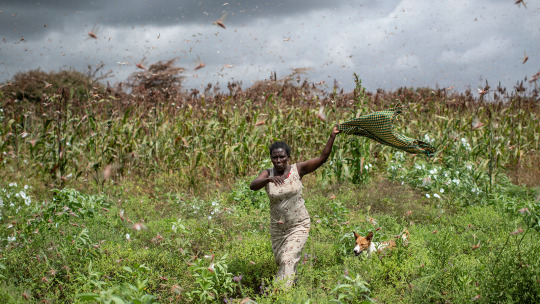
Ben Curtis/AP
1. Locusts Swarm
An unusually wet 2019 led to swampy conditions across the Horn of Africa and western Asia - giving rise to a nearly biblical swarm of locusts. There are photographs where they literally seem to black-out the sun. The culprit? Climate change. The warming waters of the Indian ocean led to stormier weather - essentially more and bigger cyclones. It’s the worst outbreak of the crop-devouring pests in a quarter-century and it threatens food security across the region. The pandemic grinds international trade to a stop - obstructing many countries efforts to buy pesticides, equipment or bring in expert help to curb the infestation. Throughout the year, these swarms ballooned in size, stretching deep into Asia and across the Pacific ocean to Argentina and Brazil. An estimated 20 million people could face hunger and starvation and the UN’s World Food Program estimates that recovery could cost upwards of $9b USD in Africa alone.
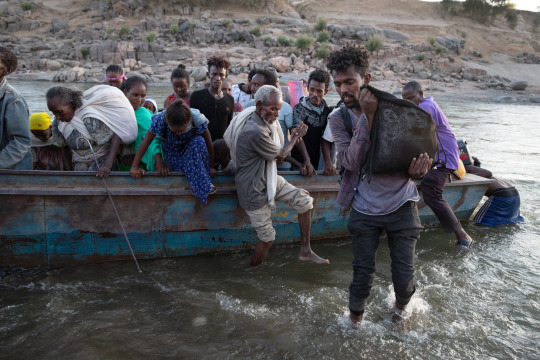
Tyler Hicks/The New York Times
2. The Tigray War
For three decades the Tigray people held the balance of political and economic power in the country, tightly controlled through the Tigray People Liberation Front (TPLF), a Tigray nationalist party. In 2018 the Ethiopian election People's Revolutionary Democratic Front, led by Oromo Prime Minister Abiy Ahmed Ali, won control of the country’s government.
Animosities boiled over when the Tigray province persisted with the 2020 election, despite government orders to postpone voting until 2021 due to the coronavirus. Prime Minister Abiy cut off funding to Tigray, incising local leadership. In November 2020, youth militias affiliated with the TPLF killed six hundred villagers in the border town of Mai Kadra - and allegedly attacked Ethiopian military bases.
The government responded by shelling the Tigray capital of Mekelle. Ethiopia’s armed forces quickly took control of the city and surrounding towns, with the militias retreating into the mountains where skirmishes have continued.
With Tigrayan people facing violent retaliation - they have faced furloughs from jobs, had bank accounts suspended, faced arbitrary raids on their homes, and been refused permission to board airplanes or travel overseas. Many have faced direct violence, especially from non-Tigray militias.
The conflict has seen incursions from Eritrean forces. Abiy was awarded a Nobel Peace Prize for his work mending the relationship with Ethiopia’s former colony-turned-neighbour. They share a common enemy now - Tigray. Eritrean forces slaughtered church-goers at a religious festival in early December, killing children and elders indiscriminately. These shadow forces of Fano militias and Eritrean soldiers have committed war crimes - including extrajudicial killings and rape. They even looted the church that allegedly houses the Ark of the Covenant.
The Tigrayan refugees have only one option: Sudan. One journalist writes: “Several [Tigrayan refugees] told me that they saw dozens of bodies along the route as they fled their shops, homes and farms and took to the long road to the border... in stifling heat.”
The New York Times series on Tigray was helpful in understanding more about the conflict and its historical and ethnic contexts. But I have to say - I feel unclear about what comes next. Will guerilla warfare between the Tigray militias and Eritrean-Ethiopian forces continue? Will the country face international consequences for their move towards genocide? I guess 2021 will decide.

A SolarWinds banner hangs outside the New York Stock Exchange on the company’s IPO day in 2018 - Brendan McDermid/Reuters
3. The SolarWinds hack
I chose to write about icebergs rather than this story for a reason. I wholly do NOT understand cyber security. Like, at all. My eyes glaze over when somebody tries to explain Wikileaks to me. I tried. I really did - I read like three articles trying to parse the details and make sense of anything and here’s what I got:
Hackers - almost certainly Russian - got into the US government secure networks. For a lot of departments. For months. It’s really, really bad. The government has a pretty blasé response to the disaster. Trump blames China. Agencies are turning directly to Microsoft for answers rather than their own cyber security people. It’s a blazing hot mess.
I’m going to continue to not understand this one, sorry.
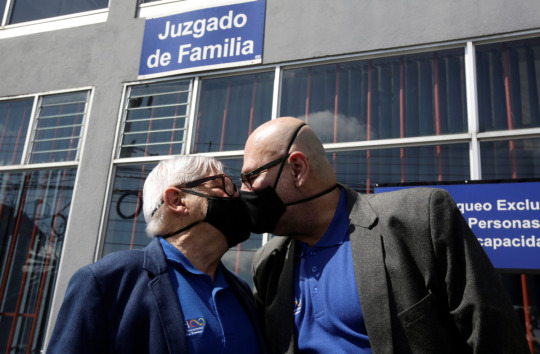
Juan Carlos Ulate/Reuters
4. Civil Rights in 2020
The expansion of civil rights in Central/South America, with the legalization of abortion in Argentina in December and the introduction of gay marriage in Costa Rica in May, gave us something to celebrate in 2020. These new rights are the result of years - and decades - of organizing by activists in these two countries.
Costa Rica is the sixth Latin-American country to legalize gay marriage. Argentina joins a short list of places in Latin America where abortion is fully legal - just Cuba, Guyana, Uruguay, and two Mexican states.
Some couples rushed to wed on the stroke of midnight - magistrates stayed up late into the night to marry couples. Marcos Castillo (L) and Rodrigo Campos (R) waited until the following morning - and celebrated with a masked kiss after their ceremony.
Other notable moments in civil rights? New Zealand officially revoked their antiquated anti-abortion laws (which they’d been effectively ignoring for years anyway), Bhutan decriminalized homosexuality, Switzerland passed legislation that will allow people to change the gender on their government IDs, and Croatia struck down laws forbidding gay couples from fostering children. Albania banned gay conversion therapy - as did the Yukon, actually - and Barbados made discrimination on the basis of sexuality illegal.
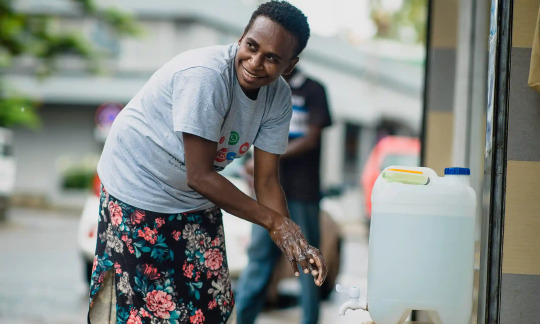
Nicky Kuautonga/The Guardian
5. Oceania crushed the pandemic
Virtually all of the countries reported to be COVID-free during 2020 were Oceanic nations and island territories. Turkmenistan says they didn’t have any cases but they’re lyin’. -Tuvalu Kiribati, Nauru, Tonga, and Palau all ended the year with no cases, while Samoa and the Solomon Islands reported a few isolated cases in quarantine facilities as they re-opened the border to repatriate their citizens abroad.
Some combination of strict travel restrictions, new hygiene rules, curfews, and early lockdowns kept most of these countries relatively untouched. While New Zealand and Australia experienced several flare-ups throughout the year, their targeted lockdowns helped eradicate community spread quickly each time, returning them to schools, workplaces and boozy brunches quickly.
Honourable mentions to Vietnam and Thailand - with 100 million and 70 million citizens apiece both have charted under 100 deaths to COVID - and Taiwan with only nine casualties.

Gulalay Amiri, a pomegranate farmer, surveys his slim haul. Fighting as worsened in many parts of Afghanistan after the United States announced they would withdraw from the country in 2021 - Jim Huylebroek for The New York Times
6. War in Afghanistan
In March the United States signed a peace-deal with the Taliban, promising to withdraw troops by May of 2021. The War in Afghanistan has lasted 19 years - the longest war in American history and the majority of my lifetime.
I don’t know how to feel about it.
During peace talks the Taliban refused to commit to recognizing the country’s elected government, disavowing Al-Qaeda or protecting women’s rights. They support limited education for girls - only up to the sixth grade.
I listened to a few podcasts by the Daily on the ground in Afghanistan with the current government’s security forces. Many of the young soldiers they interviewed were so young they’d never lived in a country governed by the Taliban - and they fiercely oppose the idea. It also appears that the Afghan government were often excluded from peace talks, finding out details of the American meetings with the Taliban through international news reports and Taliban statements on social media.
Since the Taliban’s deal with the United States, Taliban bombings and attacks have continued, targeting both security forces and civilians. The Afghan government has pointed the finger at the Taliban for mass shooting at a maternity ward in Kabul that killed 24 women and infants. “They came for the mothers”, said horrified eyewitnesses.
For almost two decades, the western world has supported the ‘new’ Afghanistan - but it feels very fragile. Will a withdrawal lead those people that assisted coalition forces vulnerable to retaliation? It feels likely. The fighting between the Taliban and the Afghan government has been fierce - and come with high civilian casualties. The year is punctuated, nearly monthly, with news of new attacks in Afghanistan.
It reminds me of the end of the Vietnam war. America withdrew and two years later the south was retaken by the North. In the final days of the Vietnam war the United States evacuated around 150,000 civilians who had worked with American on the ground. Nearly a million others left the country by boat, seeking asylum at refugee camps in Indonesia, Malaysia and the Philippines. Hundreds of thousands of Vietnamese people who had collaborated with the US-backed South were sent to re-education camps where they were sometimes tortured or starved. Is this what Afghanistan will look like?
There’s no 'good’ solution - and for now the future of the war in Afgahnistan feels very opaque. I think I under-reported stories in the region as a result - it feels too complex to boil down into daily recaps.

Bobi Wine, 38, was detained by police for allegedly breaking COVID-19 restrictions while campaigning in Uganda’s upcoming presidential election - Abubaker Lubowa/Reuters
8. Ugandan election protests
Western media doesn’t seem to place a lot of importance on reporting in Africa - but what little attention they had for the continent focused on the anti-SARS protests in Nigeria throughout the fall. The attention on police violence in America raised the profile of these demonstrations - and the brutality of the government’s response, shooting at dozens of peaceful marchers gathered at the Lekki toll bridge.
But they were far from the only protests in Africa.
As Uganda prepared for an election early in 2021, the government forcefully cracked down on youthful dissidents - like presidential hopefuls Bobi Wine and Patrick Amuriat who were detained by police during the final campaign pushes in November.
Wine, a young musician, has been arrested numerous times since he announced his candidacy. One occasion police beat Wine so badly he temporarily lost his vision - they also killed his driver. They raided his offices, confiscating election materials, and arrested supporters. His bodyguard will later be killed after being struck by a military truck while helping an injured reporter escape tear-gas during December protests.
Police record 56 casualties as they violently put down the large-scale protests - though human rights group have suggested the real number could be dramatically higher.

Ariana Quesada holds a photo of her father, Benito. He died after an outbreak at the Cargill meat-packing plant where he worked. She filed a complaint with the RCMP, asking them to investigate conditions at the plant - Justin Pennell/CBC
9. Meat packing plants become coronavirus hotspots
Meat processing plants become super-spreaders - these often rurally-located factories see massive outbreaks across the United States and Canada. Their floors are crowded with employees working elbow-to-elbow, forced to shout over the loud din of machinery. The refrigeration - necessary for keeping the meat unspoiled - may allow the virus to live longer in the air.
By September of 2020, nearly 500 meat-processing plants had reported at least one case of COVID in the United States. And 203 had died.
At a Tyson Foods factory in Waterloo, Iowa, staff allege that management placed bets on how many workers would become sick - and die. Supervisors began avoiding the floor, relegating their responsibilities to untrained workers.
The plant reluctantly closed - by the time they re-opened two weeks later over a third of their 2,800 workforce had tested positive. Five workers died - including Isidro Fernandez, whose family is leading a lawsuit against the company.
In Canada, Cargill faces a similar lawsuit after an enormous outbreak in their High River facility that resulted in three deaths - two employees and one staffer’s 71-year-old father. They were: Hiep Bui, Armando Sallegue, and Benito Quesada. The company offered a $500 “responsibility” bonus for workers who didn’t miss any shifts - and discouraged employees from reporting any flu-like symptoms. Many of the factory’s workers are temporary foreign workers or new Canadians.
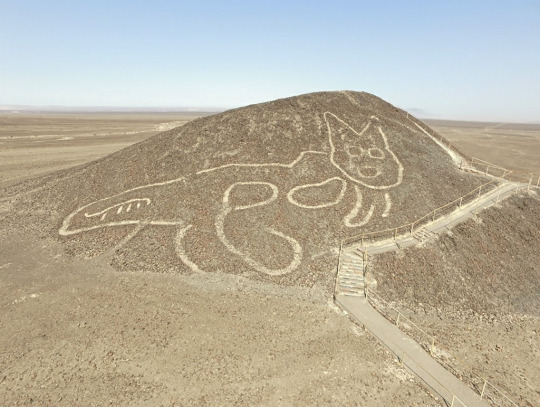
10. The Nazca Lines
I forgot about this and am shoehorning it in now, but Peruvian archaeologists discovered another ancient line drawing in the desert outside of Lima - this time in the shape of a kitty cat.
Of all the archaeology finds this year - remains at Pompeii, a mammoth graveyard in Mexico, and a wealth of sarcophagi in Egypt - this is my favourite.
1 note
·
View note
Text
The Last Postcard from Afghanistan - September 24
September 2019 Anniversaries:
18th anniversary of the Sep 11 Al Qaeda attack on the US
18th anniversary of the US attack on and invasion of Afghanistan
18th anniversary of Ahmad Shah Masoud's assasination by Arab 'journalists'
18th anniversary of the 'New Era' in Afghanistan
18th year of my involvement with the Afghan system of higher education
Elaborations:
Eurocentrism, American exceptionalism and an imperial mind-set assume, indeed compel and demand, that the entire human race must, forever, know about '9/11'. No doubt this was a major crime, but there are other significant 9/11s (Cheli)-and Afghanistan- which are hardly ever mentioned. Osama Bin Ladin and some of his Al-Qeda followers were not an Afghan creation, but Saudi-American-Pakistani agents who were invited by then Afghan pres. B Rabani and flown by Ariana Airline from Sudan to Jalalabad in the Summer of 1996. Bin Ladin had lived in Pakistan and worked closely with the Afghan mujahideen (the CIA, Mukhabarat, and ISI mercenaries) against the then leftist PDPA regime in Afghanistan. There were no Afghans among the 19 terrorists who attacked three locations in the US on Sep. 11; 17 were Saudis and two other Arabs. They planned the attack in Spain, Germany and Arizona; they took flying lessons in the US, and they used high- jacked American civilian planes in kamikazi fashion attacks on US soil. The Afghans had nothing to do with the 9/11 crime, but still, they have been subjected to and endured the most heinous collective punishment in recent history. It is said that some in the US government knew of the plot, but failed to act. When after 9/11, Washington demanded of Taliban to turn Bin Ladin over to the US, the Taliban refused, saying there was no extradition treaty between the US and Afghanistan. The Taliban also tried to avoid any confrontation with the US, and proposed that Bin Ladin could be tried by a neutral third party. The Bush administration, including the very same Dr.Khalilzad, 'the peace maker', refused the Taliban offer to negotiate, and the US launched the attack on and invasion of Afghanistan on Oct. 7, 2001. The attack was preceded by US/CIA special forces descending on Panjshair and distributing bags of money to the Northern Alliance leadership who helped the invaders. The December 2001 Bon conference was engineered by Lakhder Brahimi, Khalilzad, and the European Union which deliberately excluded the Taliban from the proceedings. Brahimi now says that was a fatal mistake. The Afghan attendees voted twice for Mr.Satar Seerat to be the interim president of Afghanistan, but again it was Khalilzad who engineered the crowning of Mr.H.Karzai as interim head of state. And when the Loya Girga in Kabul, overwhelmingly voted for former king Zahir Shah to be the constitutional head of state, again Khalilzad sabotaged the people's decision. It should be pointed out that for decades, Kalilzad the opportunist, has been dreaming and scheming about becoming Afghanistan's president, hence his complete turn around and talking to the Taliban in Doha endlessly. He belongs in the Rumsfeld, Wolfowitz and C.Rice camp. He is the Afghan Ahmad Shalabi. Pres Trump's impulsive decision to cancel the 'peace' talks must be a huge disappointment for Khalilzad.Since Oct.7, 2001, the US/NATO have been relentless in waging an unjust, illegal, and immoral war on Afghanistan, using and testing the most powerful and vicious 'full spectrum' war technology and techniques, ranging from 'the mother of all bombs' to death-squads. Although there has been some attempt at 'nation-building' here, the overall damage done to Afghanistan may take a full century to repair. As I get ready to depart for Oregon, here is a summary of where things are.
The War:
Clearly, not only has the 'war on terrorism' failed misereably, but as is abundantly clear, terrorism has in fact exploded globally, including white terrorism in the US itself. As I type this, there was a massive explosion at a political rally by candidate/president Ghani in Charikar, killing at least 26 and wounding countless. An hour later there was another explosion near the US embassy and the defence ministry in Kabul's green zone, killing 24 and wounding many. Armed opposition controls half of Afghanistan, and more so at night including roads, schools, clinics, the tax system, etc. The armed opposition can and do hit with deadly force and success anywhere in the country, including Kabul's 'green zone.' An estimated 100 Afghan National Security Forces are killed daily. About 4000 civilians are killed yearly. The ministry of public health just said that in the last 12 months, 3300 civilians were killed (40) two nights ago by US-ANSF bombing at a wedding in Helmand, and about 20,000 injured. Due to nation-wide violence and uncertainty, we the expats at AUAF in Kabul are under full lockdown for the entire month of September. In addition to the Taliban, there are now 18 different insurgent/terrorist groups including Daesh(ISI) fighting the foreigners and their puppet Afghan government. The US/NATO forces and its Afghan proxy the ANSF, have escalated the war leading to numerous military and civilian casualties. There are attacks and counter attacks everywhere-cities, towns, and villages. No one is, or feels safe or secure anywhere. Civilians all over the country are caught between the armed opposition, government forces, and the Resolute Support forces and CIA trained #02 death squads, and are either directly killed by 'mistake' or become 'collateral' casualties. Many have called for war crime investigations.There is a world wide understanding and admission that the 'war on terror' has boomeranged, that the US has lost the war in Afghanistan, and that there is no military solution to the Afghan situation, hence the cancelled US-Taliban negotiations in Doha. The forty year turmoil in Afghanistan has wreaked havoc on everything in this country.
Diplomacy:
Realizing the US war on Afghanistan was a failure and a mistake, apparently, the Obama administration tried to engage the Taliban in 2010, and for pragmatic political reasons, those attempts have been intensified over the last year in the so-called Doha talks. Somethings should be pointed out though. Pres Trump's decision to engage the Taliban is essentially based on electioneering and US economics. This is why the talks were entirely secret and just between the US and the Taliban with the complete exclusion of the US- installed and supported Afghan government and others. The talks were mostly about the American troop withdrawal and not about peace in war-torn Afghanistan. They were called 'peace talks' after the Afghans protested for being excluded and delegitimised. The US chief negotiator Dr.Z.Khalilzad, a reactionary Afghan-American, is exactly the man who excluded the Taliban from the Bon Conference in December 2001 and has been trying very hard to stay in the limelight, some day install himself as head of state in Afghanistan, or snatch an undeserved Noble Peace Prize. Some here call him 'our Ahmad Shalabi'. No one, including Trump, the US Congress, or the Afghans know exactly what he has been saying/talking about with the Taliban. Hence his subpoena by Congress last Thursday. Khalilzad says he and the Taliban have been talking about: US troop withdrawal, a guarantee by the Taliban that they will not allow anyone to launch terrorist attacks from Afghanistan, intra-Afghan dialogue, and a cease fire. No question that the Afghan problem has become extremely costly, violent, and complex, and while some in and outside of Afghanistan want it solved, there are forces who want to continue the carnage. These include the US military-industrial complex, American warlords, the evengelists, the Afghan-international drugs, weapons, human and other mafias, certain ethnic groups in Afghanistan, Afghanistan's near and abroad neighbors, the poor and unemployed Afghans, and son. There is tons of money to be made out of human suffering. And many thoughtful observers believe that regardless of peace treaties, there will be no peace in the country for a while. And all this dishonest talk of 'Afghan owned' this and that is nonsense. This is an occupied country and the country's destiny is in other peoples' hand and the Afghans own little or nothing. No human or other rights.The question is why diplomacy was rejected early on and who if anyone will be held responsible for the astronomical human and material costs and the crimes committed?
Politics:
Afghan politics, the government, and the entire political culture have always been ethnicized. The country was founded by Ahmad Shah Abdali, from the dominant Pashtoon ethnic group, who have dominated the political system and government structure whether it was a monarchy, a constitutional monarchy, a republican, a leftist regime, the Taliban or the current 'democratically' elected presidential system. It must be said though that the Pashtoons may be the privileged dominant group in name, but the vast majority have been left out of any planned progress in the country. Other ethnic groups have had to acquiese grudgingly to this arrangement. But since 2001, this power structure order has been challenged both in and outside the political system, and the Pashtoons have had to accommodate the other major ethnic groups and share power. But this power sharing has created enormous tensions, and has affected, deformed, perverted and corrupted the notions of power, politics and the political process deeply. It has produced a dysfunctional kleptocracy/plutocracy. There is now a week left for the presidential election. and there are 15 candidates. The front runners are the incumbent A.Ghani-a Pashtoon and Abdullh the current CEO-a Tajik. A great deal of horse-trading, wheeling and dealing, promises, maneuvers, even cash have been deployed to put the various tickets together. All presidential candidates have tried to be 'inclusive' and choose 'leaders' of other groups as running mates so to get support from various ethnicities. In fact, nascent political parties, movements, and groups are all invariably ethnic based, the dominant ones being Pashtoon and Tajik.. Even the candidates' dress symbolizes, project, and signify who they are and whom they are trying to mobilise; and so Mr.Ghani wears a national dress including the turban, largely a Pashtoon attire. While Abdullah the sheik 'model' wears expensive brand name western suits. All 15 candidates have assembled their tickets from the various token ethnic groups with not even a handful of women, thus hoping to attract those groups' votes. So-called ethnic leaders and/or strong men are the same warlords from the anti Soviet /PDAPA jihad in the 80s- thanks to the CIA-Mukhabarat-ISI sponsorship. All elections including on university campuses, in the last 18 years have riddled with fraud, deceit, manipulation, etc. These mujahideen have assembled/stole enormous amounts of money, power and privileges and still hold society hostage If and when old, their sons are automatically anointed as their replacement. It is all in the family.There is very little ethnic crossover for any reason. The political compaign now is particularly vicious between Ghani and Abdullah, both partners in the J.Kerry- made so-called National Unity Government in 2014. There is enormous tension, anxiety, uncertainty, and hostility in the country, some predicting and fearing another civil war between North and South, Pashtoons and the Others. Yesterday, about 40 politicians and prominent Afghans at former pres Karzai's home called for postponing the election; because they think it could plunge the country into a deep and serious crisis. As a sign of things, we the expats at AUAF have been put under complete lockdown for all of September. There may be competent, committed, and decent individuals in the government, but the system as a whole is ineffective, inefficient, incompetent, corrupt, indifferrent, insensitive, self-absorbed, and out of touch. It is a classic living example of 'the rentier state'. It seems unable and unwilling to perform anything we expect of a government, from regulating traffic to protecting the country's terretorail integrity; security to healthcare; employment to clean air. Even now, 75% of the government budget comes from foreign aid. The current government has little to no legitimacy in the eyes of the people, who are left like orphans to fend for themselves. Groups and individuals scream, yell, demonstrate, strike, protest, block, sit-in, petition, etc, but the teflon government shows little to no response. I wonder when and whether the Afghan spring may arrive to install a government of, by ,and for the people. It must be pointed out that the West has been directly complicit in this state of affairs and must accept responsibility.
The Economy:
The 'war on terror' and the infusion of massive licit and illicit foreign capital into Afghanistan ( called Foreign aid) has produced a severely deformed economy. In a perverse way, the country really is a land of 'rags to riches'! People who had nothing have become multi millionaires; there may be a handful of billionaires; this in a fourth world country! And they are not shy to flaunt their wealth, power and privileges. This new class hold foreign passports, have largely exported their wealth, and sent their families abroad to Dubai, Turkey, India, and the west. If they are in the country, they live in mansions behind huge blast walls, have guards, travel in armored SUVs with armed escorts, shop in boutique stores and department stores, eat in fancy restaurants, send their children to elite designer schools, vacation abroad, have access to the government, foreign military bases, NGOs, and foreign embassies. They are the comprador class, the contractors, the hucksters and hustlers, the mafias, the smugglers, the criminal syndicates, partners of the kleptocracy, agents for multinational corporations, and the investors. They are this country's 1%. Collectively, this class with assistance or complicity of its foreign handlers stole most of the $125 billion in foreign assistance over the last 18 years. On the other hand we have the people 60% of whom are officially under the poverty line, and the 'middle class' who are food secure. 75% of the labor force is engaged in agriculture which still uses traditional ways and means with little help from government or the foreign aid industry. There is limited industry and social service sector. The economy is largely informal and/or underground with narcotics being one-fourth of the GDP. Since the country can harvest just 30% of its water with the rest flowing out to Iran and Pakistan, this has an adverse effect on agricultural production and life in the country. There is endemic poverty in both cities and the rural areas. Per capita income hovers around $500. Two million have been displaced by war, violence, droughts, floods, conflict and son. Streets are crowded with men, women and child beggars. Millions of children work to support their families. Corruption has been normalized. 70% of the government budget still comes from foreign assistance. With a week before the presidential election, the economy is on life-support. I have never seen such poverty in both urban and rural areas. Though this is an agricultural country, but it can not even feed itself and must import grains. This grotesque inequality, poverty and degradation have led to massive violent and nonviolent crimes, white and blue collar crime, organized and retail crime. People live in fear. The culture has been gangsterized, criminalized, degraded, perverted, and trivialized. The government itself is a vast, corrupt and criminal organization. Pompeo finally declared so, and stopped a $160 aid to the Afghan government. Anyone who can, is leaving the country, even risking their lives. A recent Gallup poll ranked Afghanistan at the top of the world's misery-unhappiness-suffering-hopelessness index. Under these circumstances, war has become a means of livelihood for millions! This country has enormous resources such as water, minerals, rare and precious metals, oil, gas, gold, copper, fertile land, fruits, herbs, and people. It is indeed a shame and a crime that its people are so poor and oppressed.
Society and Culture:
Forty years of invasions (USSR, USA, NATO), war, violence, upheaval, displacement, migration, and fratricide have disfigured and fractured society deeply. Families and communities are torn apart. There is hardly a family or community which has not directly or indirectly been affected by the four-decade upheaval. People have been killed, maimed, exiled, disappeared, lost, gone crazy, have become addicts, bought and sold, dismembered, imprisoned, widowed, orphaned, etc. People are alienated and estranged from each other. There is little mutual trust, fondness, respect, help, or belonging. Older ethics, morality, conventions, and nicities are disappearing. It is a struggle of all against all and a struggle for survival, money, power, and glamour. A vicious and ugly social Darwinism prevails at all levels and all aspects of life. Lies, deceit, fraud, treachery, disloyalty, betrayal are all normatised. Ethics, morality, guilt, and shame are almost vanished from daily life. Life for the rich and the poor seems to be all about money, power, privilege, networking, consumerism, appearance, getting ahead, and/or getting by. The end justifies the means. You can now rent, buy, hire men and women sex workers, goons, assasins, and/or suicide bombers. Everything is negotiable and everyone/everything has a price. A small segment of the population seems to lead the good life, the majority simply endure life and suffer . Alien and imported culture dominates most things from language to hair style, to food, to values, to household furnishings, social etiquette, mourning to entertainment, to dress, to cosmetic surgery. There are about 100 TV networks pedling trash, vulgarity, soft core pornography, consumerism and mindlessness materialism. People, especially urbanites prefer things foreign be it fruit, clothing, machinary, language, manners, food, education, medicine, and products you name it. People inevitably opt for the imported stuff regardless of the quality, inauthenticity, fitness, price, or threat and damage to indigenous ways. Most things about the country, from war to peace, education, foreign policy, technology, economic policy, trade, and commerce, aspects of language are decided from outside. People appear resigned and reconciled, they lack initiative, throw their hands in the air and see their destiny in the hands of Allah, the Americans(and other foreigners) and/or the dysfunctional government. There is little to no collective or individual sense of agency. People seem bewildered, anxious, fearful, uncertain and hopeless. They entrust themselves to God, fate, the extremists, or the West. Since society and culture seem to be under siege, certain elements, including the Taliban, have become extreme xenophobes rejecting all things foreign, hence the polarization of society between tradition and modernity, urban and rural. The country is in a very deep crisis, but very few seem to realize or care.
Education:
At the invitation of the first post-Taliban minister of higher education, Dr.Sharif Fayez, also an Afghan American academic, I arrived in Kabul in early March, 2002. I could not believe what I saw. I literally wept when I saw how my middle and high schools, like the entire country, were ravaged by the prolonged wars. The education system from top to bottom was severely limited in scope, purpose quality and quantity. Like the country itself, education too had become a wasteland. The ministry of higher education building had no running water so we had to use an outhouse. And I lived in a simple house with no in-door plumbing. There were just two old manual Pashto and Dari typewriters. Very few of us had phones. There was no internet or computers, or other technology in the building. Electricity was irregular so we begged UNESCO to get us a generator. There were just five public universities with about seven thousand students, mostly men. Other than delapidated buildings, there was nothing to little else you expect at a university.The system was isolated, archaic, underfunded, substandard, dysfunctional and useless. The system was gripped by mediocrity, tradition, ideologies, culture and religion. We had a monumental challenge to rebuild the education system. A few international organizations arrived to help. What I do remember was our commitment, dedication, determination, hope, and optimism. Afew Afghans and internationals believed we could modernize and rebuild the Afghan higher education, even against all odds. Everyone was thirsty for a good education. Although I was a tenured and full professor at Lewis and Clark College in Portland, Oregon, and had full responsibilities, but seeing the desperate situation in Afghanistan, I had to find ways to help. So L and C was kind enough to allow me to teach my full load at L and C during Spring and Summer and spend August to January in Kabul every year from 2002 to 2014. I served as senior adviser and handy man to the minister from 2002 to 2006. Around that, the government including the ministry of higher education, started to become ethnicised. Thus in 2006, I joined the University of Massachusetts team to design and teach in its MA program for university instructors from all of Afghanistan, at the Kabul Education University. KEU was later renamed Shaid Rabani Education University. Later the U of Mass and I designed an MPPA( master of public policy and administration) program at Kabul University, and I taught in that program during 2012-215. Since I worked two challenges jobs between 2002 and 2013, I began to feel tired. Late in 20013, I was offered a full time position to design, direct, and teach an MA Ed program at the American University of Afghanistan. This was to train 1000 trainers from two year teacher training institutions from all of Afghanistan. So I resigned my position at LC and joined AUAF as full professor and director of MAEd in 2013/14. In the summer of 2015, I was asked to design, teach in, and direct another. MA program in education and law enforcement at AUAF for the police academy instructors. That program ended on Sep.1, 2019.There has in fact been a big increase in the number of students, schools and tertiary institutions both public and private since 2002. There are now some nine million pupils, attending some 217000 schools; 38 public institutions and 140 odd private institutions of higher learning with 140000 and 150000 students. Half of the public schools have no buildings! Education is free from first grade to college. Most of the private universities are run in large rented houses.Though some 5 million school-age children and 93% of college -age youth still have no access to school and the quality of education at all levels is substandard. At the same time 80% of the women and 65% of the men in the country are illiterate. Most of what is called education is out of sink with the country's socioeconomic and cultural reality; it is shallow, substandard, and dysfunctional producing millions of un/underemployed academic prolitarriate constituting a huge socioeconomic problem and a time-bomb. There are reasons for this state of affairs. Insufficient funds is the main reason, with the country spending one the lowest amount per student in the world. Lack of capacity to run effective and efficient organizations is another reason.The two ministries for education can not even spend one-third of their development budget. Leadership changes is another reason. Government organizations are crippled by ethnic, political, or personal factionalism. The notion of an independent, competent, clean, secure, and stable civil service does not exist here.There have been 8 ministers of higher education and that many ministers of education since 2002; and to my knowledge, none were trained professional educators. All appointments at all levels are politicized and ethnicized, based on bribes, nepotism, or deal-making; the patronage and poenage system prevails. Most international experts are themselves under and/or unqualified and out of touch with the local realities. In case of women and girls 'culture' itself is a huge barrier to their education. And schooling and education are not viewed so much as a means to transform the individual or the society, but a way to make a living and/or get ahead.
As my departure nears, I have mixed emotions. On the one hand, I have spent a lot of time and energy here over the last 18 years, trying to make a difference. I have endured frustration, hadship, stress and strain, and even risked health and life. And I care deeply about family, friends, coworkers, indeed all the people here who have to endure so much. Any people should not be subjected to so much brutality, pain, suffering and deprivation.. It offends and pains me greatly. And I have contempt for the predatory class and the various criminal syndicates for their inhumanity. To me they are almost like animals. And I also hold the US ruling class and its 'allies' responsible for this state of affairs. On the other hand, I know full well that there are limits to our endurance, and I feel that for now, I have reached my limits. And my wife Tahmina needs/wants out of here too. We know what lies ahead for us in Portland, but the US is by no means Afghanistan and we expect better. So if all goes well, we depart Kabul and arrive in Portland on October 2nd. I will, after a two weeks readjustment period, be happy/available to share my observations with anyone who is interested and concerned. Please feel free to share this report.Those interested, can Google Zaher Wahab Tumblr, and read these reports starting in 2009.
Zaher Wahab
Kabul Sep. 24,2019
2 notes
·
View notes
Text
Summer 2002 Road Trip: Kabul-Kandahar-Herat
Photos and imagery by Fariba Nawa
From the June 2004 issue of Afghan Magazine | Lemar-Aftaab

[caption: Tile work at the Gazargah shrine, Herat province.]
I traveled through Afghanistan in the fall of 2000 during the Taliban era and then returned in 2002 and 2003 to report for various publications and radio programs. These pictures are from the summer of 2002, when I took a cross-country road trip from Kabul, through Kandahar, and then to Herat, my hometown. This was before any roads were repaired, and during a time when many Afghans were still hopeful for change.
As a child, I lived in Kandahar, Helmand, and Herat. Now with American and European journalists as my travel mates, I traced back memories from my childhood, visiting sites like the Helmand River and the Gazergah shrine. I went to schools, shrines, bazaars, and private homes, talking to Afghans from every background and age to gauge the mood of the country.
We took a taxi on the road from Kandahar to Herat. It was a nine-hour ride through a dangerous zone where three people had been killed three days before. Our driver was easy-going, almost fearless, speeding at 90 mph on the cracked roads. We stopped for lunch at a roadside restaurant, and then our driver lit up his usual after-lunch joint. He smoked it as he drove.
My Spanish companion and I were not happy with his dessert. But our German photographer seemed amused. She was sitting in the front and taking photos of him.
"I can drive blindfolded through these roads," he told us with confidence.
Meanwhile, a group of turbaned men with Kalashnikovs jumped out from behind the small hills motioning us to stop with their guns. Our heartbeats accelerated as our car slowed to a stop. I had heard stories of road lootings, but this would be worse. We were all women and foreign women with a lot of cash on hand. We told the driver to keep going. He didn't listen. I somehow felt responsible for these women because I was the Afghan. A thousand things went through my mind. Will they rape us, kills us, and take our money? I clutched onto the door handle as one of the men stuck his head in the window and asked the driver for something in Pashtu.
I can barely understand Pashtu, but I could tell it was about money. We sat motionless, hoping the driver could rescue us. The driver handed the man a 40,000 afghani note, $1 then, said goodbye and drove off. The women looked dumbfounded. I asked the driver what had happened.
"They were just collecting toll. This is how people in this area make their money."
I wasn't sure whether to laugh or cry.
Join me on this journey.
Kabul
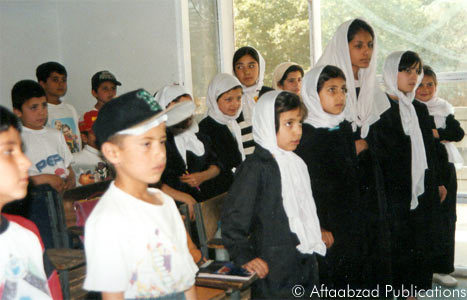
[caption: This is a co-education school in the Kabul neighborhood of Wazir Akbar Khan, which is one of the few areas in the capital left unscathed by war, although it suffers from years of neglect.]

[caption: A young girl gazes at the chalkboard absorbing the day's lessons.]
Kandahar

[caption: A view of the old city in Kandahar. Most Afghan cities and large towns are divided between old and new sections.]

[caption: Children at the Kandahar bazaar. It is common to see small children out alone, running errands for their parents, and taking care of younger siblings.]
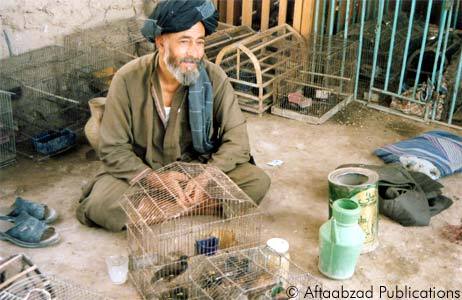
[caption: This bird seller at the Kandahar bazaar sells most of his birds to vendors who make them fight against each other, similar to cockfighting.]

[caption: A young office assistant at the World Food Program. During her downtime, she uses the computer to draw portraits. She wants to be an artist.]
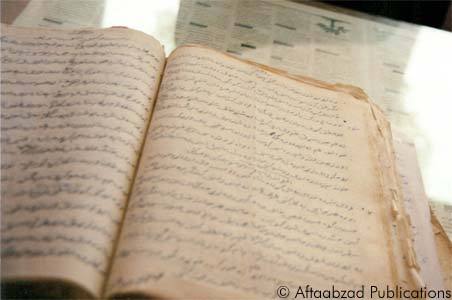
[caption: A 100-year-old Pashtu manuscript brought to the office of Culture and Information for preservation.]
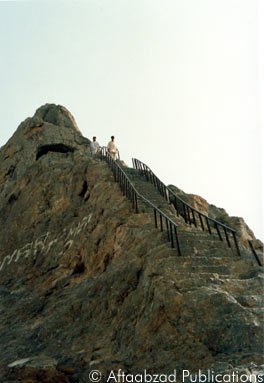
[caption: Located near the old city of Kandahar, the Chihil Zina (Forty Steps) were built in the 16th century by Babur Shah, founder of the Moghul Empire. Inside the cave at the top of the steps, letters carved into the stone pay tribute to Babur Shah. This is one of Kandahar's most treasured historic sites.]
Kandahar to Herat
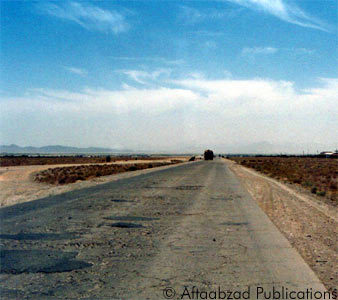
[caption: The bombed-out road from Kandahar to Herat. Drivers speed at 90 mph diving off the path to avoid destroyed bridges and then climbing back up. The drive takes nine hours to reach Herat city after passing three other provinces.]
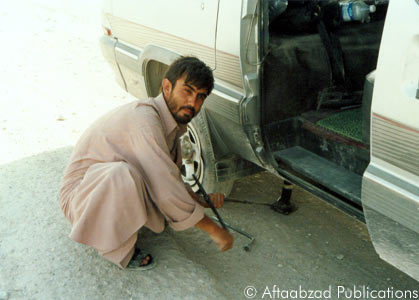
[caption: Nasir, the driver for the Chicago Tribune, changes his seventh tire on the Tunis van. It took us about 17 hours from Kabul to Kandahar on the old, destroyed road. Now that the road has been rebuilt, the trip takes only five hours.]

[caption: Deserted Soviet army barracks. The fields are littered with mines en route to Herat.]

[caption: A taxi driver takes three women journalists, including me, from Kandahar to Herat. He rolls his joint and smokes his daily after-lunch hashish as he drives. "I can drive on this road with my eyes closed. Don't worry," he tells the frightened women.]
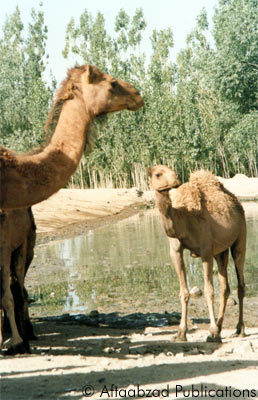
[caption: Camels are still common in rural Afghanistan. Nomads use them for transportation.]
Herat: Historic Sites
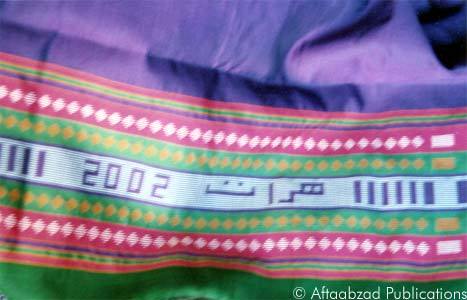
[caption: Around the majestic Friday Mosque in Herat City, men make colorful crafts including handmade silk shawls. This shawl reads "Herat 2002."]

[caption: One of the minarets built in Herat's cultural renaissance in the 15th century during Timurid rule. They encircle the Gowharshad shrine and school, another landmark from the same era.]

[caption: The Friday Mosque (Masjid-e Jami) is a sanctuary for Sufis and vagabonds. It is one of the cleanest public places in the city with gleaming handmade tiles and marble floors. It is among the finest Islamic buildings in the world. The structure is built on the platform of a Fire Temple dating back to the Zoroastrian period.]

[caption: The Friday Mosque's main entrance. The mosque is decorated with beautiful Timurid tilework and calligraphy.]

[caption: Another view of the Friday Mosque.]

[caption: A malang (Sufi wanderer) in a trance at the Friday Mosque.]
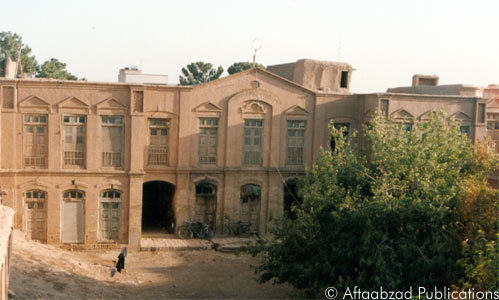
[caption: Near the Friday Mosque are homes from a century ago. The architecture is common to the Islamic world with high ceilings, arches, and fountains in the courtyard. These homes are not being restored. Instead, Afghans are building boxy, whitewashed, modern-style houses modeled after those in Iran.]
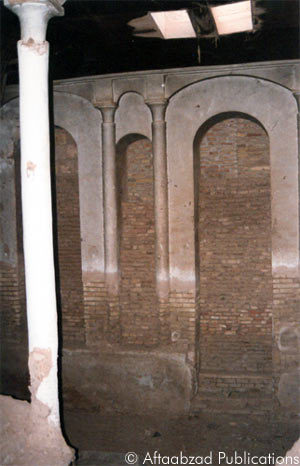
[caption: This was once an indoor pool in one of the old houses.]
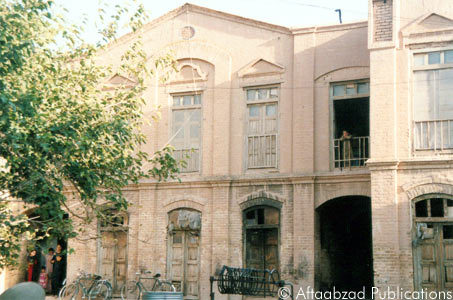
[caption: The family who lives in this house has been here for generations. But they are not sentimental about the fact that they have no running water or electricity.]

[caption: The view of the Friday Mosque from the roof of the old house.]
Herat: Crafts

[caption: In the corridors of the Friday mosque, workers bake and color tiles that will be used for the facades of other buildings in the city.]

[caption: A tile maker designs tiles.]
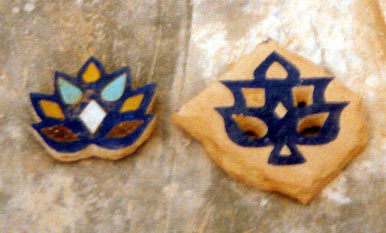
[caption: A finished tile looks something like the flower on the left.]
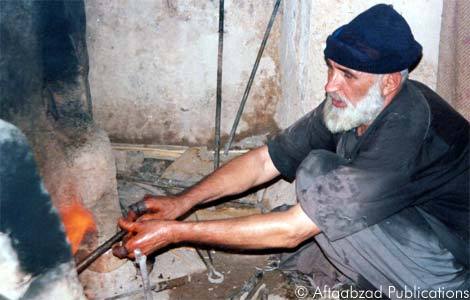
[caption: The glassblower of Herat. He has been blowing blue glass, an authentic Herati craft, for 30 years in front of the Friday Mosque. His young sons aid him in the laborious work, as they endure smoke and 120-degree heat inside a clay hut. "The foreigners come to see how interesting what I do is and how beautiful the glass turns out, but if I could trade this for another job, I'd take it in a second," he says.]
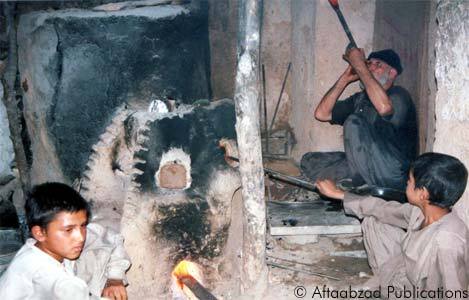
[caption: The father and his sons are busy at work.]

[caption: Designing the glass is a skillful task.]

[caption: Journalist Angeles Espinosa from Spain's premier newspaper El Pais visits the antique shop where the handmade glass is sold.]
Herat: City
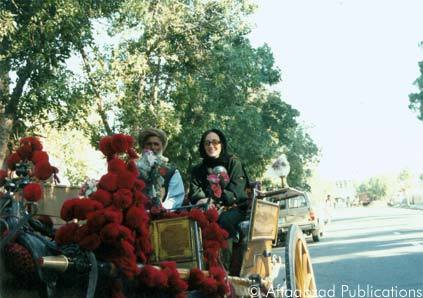
[caption: Riding in a horse wagon is a form of transportation in Herat.]
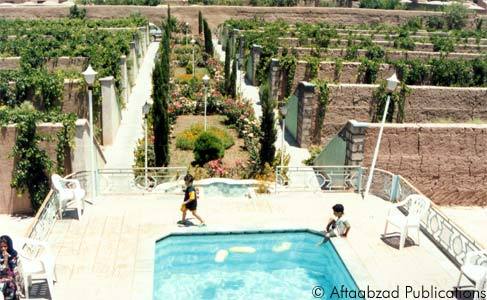
[caption: One of the many sparkling gardens rented out for private family parties on the outskirts of the city. Families gather here on Fridays to picnic and swim.]

[caption: Most homes in Herat have fruit trees and grapevines. Families pluck their dessert right from their yards.]
Herat: Education
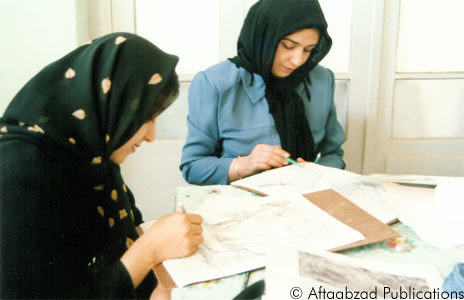
[caption: Students at the Fine Arts College at Herat University. The classes are segregated by gender, but men and women study at the same university.]
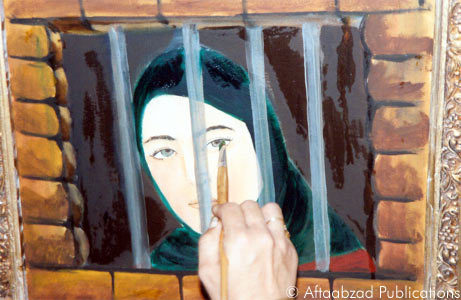
[caption: Roia Hamid, a 26-year-old recent graduate of the Fine Arts College at Herat University, draws the image of a woman behind bars. Tears drip down from the sky to her face. "This is how I felt when the Taliban ruled here," Hamid says.]

[caption: Hamid's paintings. She copied this from a book lying around in her house.]

[caption: One of the students displays his work in the classroom. The men and women of the Fine Arts College organized a gallery exhibit. Some pieces sold for more than $1,000. The students are influenced by many art schools, including the classical school of Behzad, the 15th century Herati artist who established a unique style of miniature painting, often referred to as the "Rafael of the East".]

[caption: Young girls in school in uniform. At their age, a burka is not necessary.]
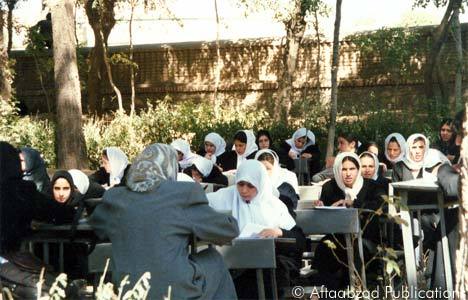
[caption: Classrooms in high schools are so full that students have to sit outside for exams. This group of girls is taking a geography test.]
Herat: Country and Camps
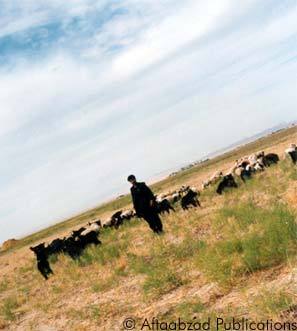
[caption: Ishaq Norzi, an Afghan who lives in Iran, visits his family land in Ghorian, a village two hours from Herat city.]
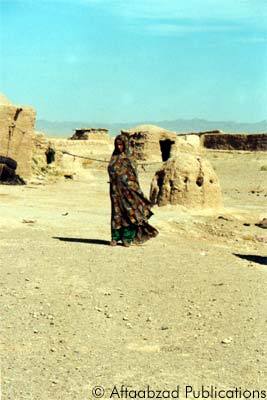
[caption: A young woman in Ghorian village, one of the most devastated areas in the province. It's one of the drug trafficking routes to Iran and the men and women in Ghorian live on the drug trade. This woman is an opium addict living in a clay hut in the desert.]
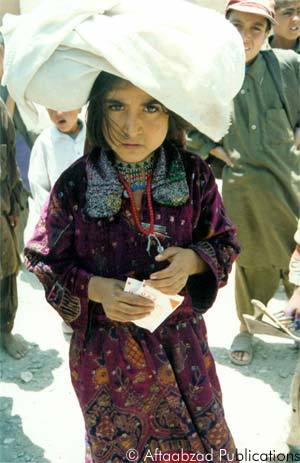
[caption: A young girl at the internally displaced refugee camp of Maslakh carries bread on her head. Many of the camps inside the country are closing as people return to their homes, but Maslakh remains open for the most down and out refugees.]
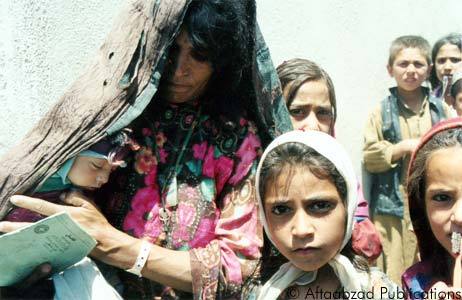
[caption: A mother and infant stand in line to see the camp doctor. Camp residents suffer from cholera, malaria, diarrhea, typhoid, and many other diseases. Ailments in the West that are easily treated become a death sentence to many in Afghanistan who have limited access to health care.]

[caption: The camp bazaar. Refugees find innovative merchandise to sell from sweets to blankets.]
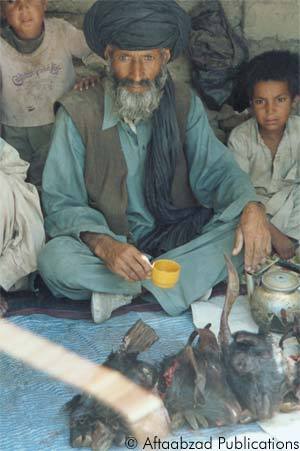
[caption: Goat heads or is it sheep?]
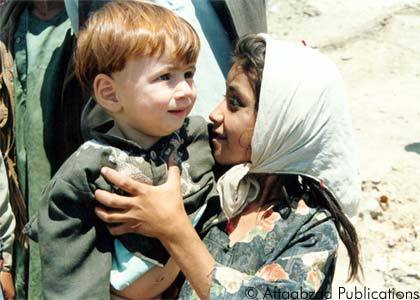
[caption: Young girls take care of their younger siblings as if they are the mothers.]

[caption: Some girls shy away from the camera; others own it with their smile.]

[caption: Maslakh's brightest smiles and its hope.]
Herat: Gazargah

[caption: It is an honor to be buried in the cemetery next to the Gazergah shrine, located 3 miles east of Herat city. The 15th century Timurid ruler Shah Rukh built the complex of buildings around the shrine.]
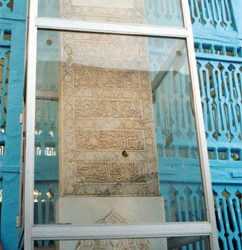
[caption: The Gazergah shrine of Khoja Abdullah Ansary, the renowned 11th-century Sufi poet. Afghans from every walk of life gather here to pray and give alms. The shrine and its surrounding cemetery, mosque, and garden belong to the Mir family, descendants of the poet.]
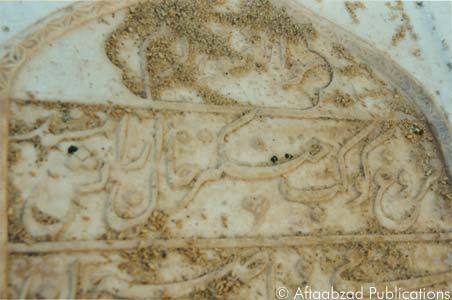
[caption: Centuries-old Persian calligraphy remains on the walls of the shrine.]
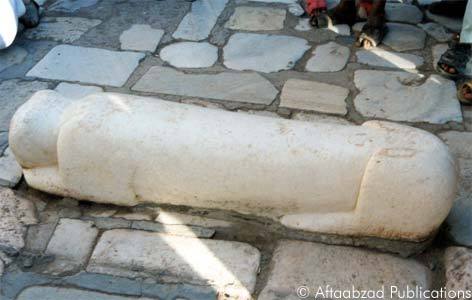
[caption: The gatekeepers of the shrine hid this statue of a lying dog from the Taliban. The architect who built the shrine represented himself as a dog to show his loyalty to the great poet, Ansary.]
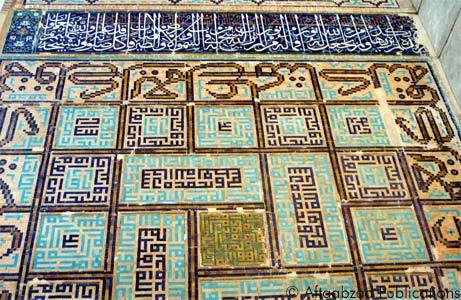
[caption: Lavishly decorated tile work at the shrine.]
About Fariba Nawa فریبا نوا
Fariba Nawa, an award-winning Afghan-American journalist, covers a range of issues and specializes in women’s rights and conflict zones. She is based in Istanbul, Turkey and has traveled extensively to the Middle East, Central and South Asia. Visit Her Website
1 note
·
View note
Text
The way to eat
The way to eat
Khyber Pass (Khyber Pass in English) is a mountain pass in the Khyber-Pakhtunkhwa province of Pakistan (Indian-Pakistan-occupied Kashmir). The crossing is near the international border with Afghanistan. The hill, which crosses the Spin House Mountains, connects the town of Jamrud in the Peshawar Valley to the town of Landi Kotal. In ancient times, this hill was part of the Silk Road; So it was an important road from a commercial, cultural, economic and political point of view. Since the Khyber Pass was an important trade route between the Central Asian continent and the Indian subcontinent, all the rulers were trying to control it militarily. The Khyber Pass is part of the Asian Highway 1. The area is predominantly Afridi and Pashtun Shinwari.
History-- In the past, Cyrus, the first Darius, Genghis Khan, and later the Diwas, Kutlugh Khwaja, and some of the Mongols, such as Kabek, contributed to the Khyber Pass. Before the Kushan Empire, Khyber Pass was not a well-known trade route. In the past, the Khyber Pass was part of the Silk Road, which stretched from Shanghai, China, to the eastern Spanish city of Cadiz. The Pahlavi Empire tried to control the trade of silk, pearls, precious stones and other luxury goods from China to West Asia and Europe. Due to the Khyber Pakhtunkhwa route, elephant ivory, lanka, black pepper and cloth could be transported from Takshashila to Bagram, making it a major trading center in Gandha, Afghanistan. The invaders, Mohammad Ghori, Mamud Ghazni, the Mongols and the Turks, entered the Indian subcontinent through the Khyber Pass. Later, during the reign of Ranjit Singh in 1834, the Sikh Empire took over the Khyber Pass. Sikh army chief Hari Singh Nalwa has been in charge of controlling the Khyber Pass for many years, and his name is well-known in Afghanistan. 186 In the British-ruled India, the phrase "Khyber se Kanyakumari" was used in Hindi to indicate the geographical extent of India. The northern part of the Khyber Pakhtunkhwa is inhabited by the Mulagori people. To the south of the hill are the Afridi Tiraha and the villages on the hill are inhabited by the Pashtun Afridi people. In ancient times, Pashtun Afridi and Afghan shinwari used to call Khyber their territory and collect taxes from traders and travelers who used it. Since ancient times, the Khyber Pakhtunkhwa has been a source of income for these tribes, and the people of this caste have always been opposed to the rule of the Khyber by others. After World War I, the British ruling India built a railway line through the Khyber Pass. The railway, which was built in 1925 from Jamrud near Peshawar to Landi Kotal on the Afghan border, was inaugurated. In the wake of World War II, the German army and tanks feared an invasion of India by the British, who built a wall at Khyber, known as the Dragons' Teeth. The mountain is known to many Western and Japanese tourists. Passengers from Kabul to the Afghan border by bus or car were already warned as they were likely to enter the tribal areas of Khyber Pakhtunkhwa. So far, various places built by the British can be seen in Khyber Pakhtunkhwa. It is alleged that the ambassador provided the information to Hussein.
0 notes
Photo


The Fine Arts Library holds the photographic archives of former faculty members as well the work of other architectural and ethnographic scholars including Josephine Powell.
Born in New York, photographer and ethnographic collector Josephine Powell received an MA in social work from Columbia University in 1945. After teaching herself how to use a camera, she moved to Rome and began work in 1953 as a freelance photographer specializing in art, architecture, and ethnography. In 1974, she moved to Istanbul and remained there, becoming an expert on the villages, nomads, and textiles of Anatolia. Throughout her career as a photographer she traveled widely in Europe, the Middle East, India, and Northern Africa. The collection includes photographs documenting the architecture, art, culture, and ethnology of countries in the Middle East and North Africa; Central, South, and Southeast Asia; and Italy, Greece, and the Balkans. Images of art and architecture show frescoes, mosaics, and sculpture, including many stone-carved reliefs; textile and other decorative arts, with many objects from museum collections in Kabul, Peshawar, Delhi, and elsewhere; and architectural images, including Islamic, Byzantine, Hindu and Buddhist structures. Ethnographic images, mostly from Afghanistan, India, and Pakistan, include portraits and scenes of daily life in cities, towns, and rural areas showing men, women, and children of different ethnic groups and religions, including nomadic people engaged in various activities, such as weaving, pottery, farming, fishing, music, dancing, festivals, and ceremonies.
In these photographs, Powell focused on architectural and decorative details of Tashkurgan Bazaar scenes in Afghanistan. Tashkurgan (or Tashqurghan) is famous for their covered markets, and Powell also captured many lively scenes from those markets.
Tashkurgan. Bazaar, interior. Cupola, decorations. Embroidered cap stand below
Title :Powell AF10-[246] Color
Powell, Josephine, 1919-2007, American [photographer]
Tashkurgan. Bazaar, interior. Cupola, detail
Powell, Josephine
Creation date: 1959-1961
Provenance: Josephine Powell Collection
Creation date: 1959-1961
Harvard Fine Arts Library Special Collections
#josephinepowell#photography#fineartslibrary#harvardfineartslibrary#harvardfineartslib#Harvard#harvard library#special collections
25 notes
·
View notes
Text
Stop Doing This In Kabul
Stop Doing This In Kabul
BEST ACCOMMODATION DEALS IN KABUL HERE
GET TO KNOW THE CITY
Kabul is the capital and largest city in Afghanistan. It has a population of around 4.6 million people and is divided into 22 districts. Its rapid urbanization makes it the world’s 75th largest city.
Kabul is located in a valley between the Hindu Kush Mountains and the Kabul River, making it one of the world’s highest capital cities.…
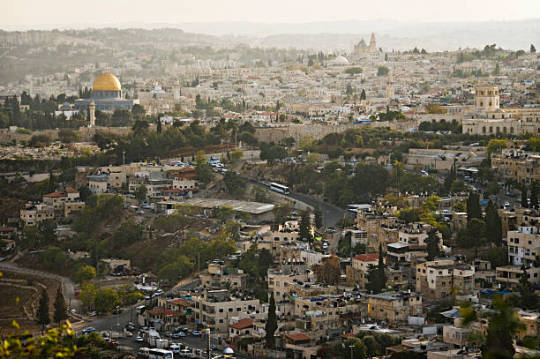
View On WordPress
#afganistan women protest in kabul#afghanistan kabul news#gurdwara attacked in kabul#gurdwara attacked in kabul afghanistan#gurudwara attacked in kabul#isis suicide bombs at kabul#kabul#kabul (city/town/village)#kabul airport#kabul airport bombings#kabul airport bombs#kabul airport news#kabul airport today#kabul news#kabul sikh attack#old kabul#suicide bomber in kabul#taliban in kabul#taliban kabul#taliban kabul news
0 notes
Text

Harrogate, UK 🇬🇧! A Zelkova serrata Bonsai tree is displayed in the run-up to the Harrogate autumn flower show. Set in the grounds of Newby Hall, one of England’s finest stately homes, the show takes place on 17-19 September and will include garden installations, plant nurseries, and a giant vegetable competition. Photograph: Ian Forsyth/Getty Images

London, England 🏴! A curator displays international driving permits that belonged to Muriel Gardiner, an American who fought fascism in the 1930s, saving many lives, and whose own life put her at the centre of a circle that included Sigmund and Anna Freud. ‘Code Name Mary: The extraordinary life of Muriel Gardiner’ opens at the Freud Museum London on 18 September. Photograph: Freud Museum London

Hatay, Turkey 🇹🇷! Lightning strikes over the Gulf of İskenderun. Photograph: Anadolu Agency/Getty Images

Badakhshan province, 2004, Afghanistan 🇦🇫! Local girls in the remote village of Ghumaipayan Mahnow watch UN workers delivering ballot papers. Photograph: Emilio Morenatti

Kabul, 2006, Afghanistan 🇦🇫! An Afghan family sits on the mountain side as thousands of people gathered to look down on the Sakhi shrine, where a ceremony celebrating the New Year took place. Photograph: David Guttenfelder

New York, New York, USA 🇺🇸! Lightning strikes the One World Trade Center during a thunderstorm, as seen from Jersey City. Photograph: Gary Hershorn/Getty Images

New York, New York, USA 🇺🇸! Demonstrators gather at a ‘freedom rally’ to protest against Covid-19 vaccination mandates. Photograph: Anadolu Agency/Getty Images

Cairo, Egypt 🇪🇬! Visitors with umbrellas shelter from the sun while viewing the step pyramid of Pharaoh Djoser of the third dynasty at the Saqqara Necropolis. Photograph: AFP/Getty Images

East Sussex, England 🏴! A Winnie the Pooh inspired house in the Ashdown Forest which is available to book on Airbnb as part of Disney’s 95th Anniversary celebrations of the children’s character. Photograph: Henry Woide/Airbnb/PA

Seal Island, False Bay near Cape, South Africa 🇿🇦! Town A Flying Great White Shark! Air Jaws (2001) by Chris Fallows. Photograph: Chris Fallows
1 note
·
View note
Text
Thursday, August 19, 2021
Fueled by winds, largest wildfire moves near California city
(AP) A wildfire raged through a small Northern California forest town Tuesday, burning dozens of homes as dangerously dry and windy weather also continued to fuel other massive blazes and prompted the nation’s largest utility to begin shutting off power to 51,000 customers. The Caldor fire in the northern Sierra Nevada had burned an estimated 50 homes in and around Grizzly Flats, a town of about 1,200 people, fire officials said at a community meeting. To the north the Dixie Fire—the largest of some 100 active wildfires in more than a dozen Western states—was advancing toward Susanville, population about 18,000. Meanwhile, Pacific Gas & Electric announced it had begun shutting off power to some 51,000 customers in small portions of 18 northern counties to prevent winds from knocking down or fouling power lines and sparking new blazes.
Wet and unwelcome, Fred spawns twisters and flooding in US
(AP) Tropical Storm Fred weakened to a depression and spawned several apparent tornadoes in Georgia and North Carolina on Tuesday as it dumped heavy rains into the Appalachian mountains along a path that could cause flash floods as far north as upstate New York. Fewer than 30,000 customers were without power in Florida and Georgia after the storm crashed ashore late Monday afternoon near Cape San Blas in the Florida Panhandle. Emergency crews were repairing downed power lines and clearing toppled trees in Fred’s aftermath. Some schools and colleges in Florida, Alabama and Georgia canceled Tuesday’s in-person classes due to the storm.
Injured in Haiti’s quake continue to show up at hospitals
(AP) The problems in Haiti may be summed up by the public hospital in L’Asile, deep in a remote stretch of countryside in the nation’s southwest area. Here, a full four days after a powerful earthquake hit this region the hardest, people are still showing up from isolated villages with broken arms and legs. Hospital director Sonel Fevry said five such patients showed up Tuesday, the same day officials raised the disaster’s death toll by more than 500. Grinding poverty, poor roads and faith in natural medicine all conspire to make the problems worse. “We do what we can, remove the necrotized tissue and give them antibiotics and try to get them a splint,” Fevry said, adding that road access to the facility in the department of Nippes is difficult and not everyone can make it. On Tuesday night, Haiti’s Civil Protection Agency put the number of deaths from Saturday’s earthquake at 1,941. It also said 9,900 were injured. Officials said the magnitude 7.2 earthquake destroyed more than 7,000 homes and damaged nearly 5,000, leaving about 30,000 families homeless. Hospitals, schools, offices and churches also were demolished or badly damaged.
Wildfire raging near French Riviera kills 2, injures 27
(AP) A wildfire near the French Riviera killed two people and was burning out of control Wednesday in the forests of the popular region, fueled by wind and drought. Over 1,100 firefighters were battling the flames and thousands of tourists and locals were evacuated to safer areas. The fire started Monday evening 40 kilometers (24 miles) inland from the coastal resort of Saint-Tropez. Whipped up by powerful seasonal winds coming off the Mediterranean Sea, the fire had burned 7,000 hectares (17,300 acres) of forest by Wednesday morning, local officials said.
China’s drills
(Foreign Policy) China conducted assault drills with warships, fighter jets, and anti-submarine aircraft close to Taiwan on Tuesday in response to what Beijing has called “provocations” threatening China’s sovereignty. Taiwan’s Defense Ministry has responded coolly, saying it “has a full grasp and has made a full assessment of the situation in the Taiwan Strait region, as well as related developments at sea and in the air, and is prepared for various responses.” The drills came after Washington approved a weapons sale to Taiwan in a deal valued at up to $750 million two weeks ago, and as Beijing has ramped up military activity around the island in recent months. In June, China’s air force flew 28 fighter jets into Taiwan’s air defense identification zone, the largest daily incursion on record.
New Zealand’s first coronavirus case in six months sends country into lockdown
(Washington Post) One coronavirus case. That’s all it took to send New Zealand into a three-day, nationwide lockdown late Tuesday as the country’s six-month streak without local transmission came to an end. Auckland, the largest city, where the new case was detected, is likely to be shut down for seven days. Prime Minister Jacinda Ardern said she was ordering the country’s harshest shutdown in more than a year given the strong likelihood that the case was the more infectious delta variant, with genomic test results expected overnight. She appealed to New Zealanders not to go out unnecessarily.
Why Afghan Forces So Quickly Laid Down Their Arms
(Politico) In the winter of 1989, as a journalist for the Times of London, I accompanied a group of mujahedeen fighters in Afghanistan’s Ghazni province. At one point, a fortified military post became visible on the other side of a valley. As we got closer, the flag flying above it also became visible—the flag of the Afghan Communist state, which the mujahedeen were fighting to overthrow. “Isn’t that a government post?” I asked my interpreter. “Yes,” he replied. “Can’t they see us?” I asked. “Yes,” he replied. “Shouldn’t we hide?” I squeaked. “No, no, don’t worry,” he replied reassuringly. “We have an arrangement.” I remembered this episode three years later, when the Communist state eventually fell to the mujahedeen; six years later, as the Taliban swept across much of Afghanistan; and again this week, as the country collapses in the face of another Taliban assault. Such “arrangements”—in which opposing factions agree not to fight, or even to trade soldiers in exchange for safe passage—are critical to understanding why the Afghan army today has collapsed so quickly (and, for the most part, without violence). The same was true when the Communist state collapsed in 1992, and the practice persisted in many places as the Taliban advanced later in the 1990s. Over the past 20 years, U.S. military and intelligence services have generally either not understood or chosen to ignore this dynamic. That the U.S. government could not foresee—or, perhaps, refused to admit—that beleaguered Afghan forces would continue a long-standing practice of cutting deals with the Taliban illustrates precisely the same naivete with which America has prosecuted the Afghanistan war for years.
Russia says Afghan president fled with cars and helicopter full of cash
(Reuters) Russia’s embassy in Kabul said on Monday that Afghan President Ashraf Ghani had fled the country with four cars and a helicopter full of cash and had to leave some money behind as it would not all fit in, the RIA news agency reported. Ghani, whose current whereabouts are unknown, said he left Afghanistan on Sunday as the Taliban entered Kabul virtually unopposed. He said he wanted to avoid bloodshed. “As for the collapse of the (outgoing) regime, it is most eloquently characterised by the way Ghani fled Afghanistan,” Nikita Ishchenko, a spokesman for the Russian embassy in Kabul, was quoted as saying by RIA. “Four cars were full of money, they tried to stuff another part of the money into a helicopter, but not all of it fit. And some of the money was left lying on the tarmac,” he was quoted as saying.
Gorbachev, leader who pulled Soviets from Afghanistan, says U.S. campaign was doomed from start
(Reuters) Mikhail Gorbachev, the leader who oversaw the withdrawal of Soviet forces from Afghanistan in 1989 after Moscow’s failed decade-long campaign there, said on Tuesday that NATO’s own deployment to the country had been doomed from the start. Gorbachev was cited by Russia’s RIA news agency as saying that NATO and the Americans had no chance of success and had badly mishandled their own Afghan campaign. “They (NATO and the United States) should have admitted failure earlier. The important thing now is to draw the lessons from what happened and make sure that similar mistakes are not repeated,” Gorbachev told RIA. “Like many other similar projects at its heart lay the exaggeration of a threat and poorly defined geopolitical ideas. To that were added unrealistic attempts to democratize a society made up of many tribes.”
Regional Powers Assess a New Afghanistan
(Foreign Policy) As the United States continues to mount an evacuation effort from Afghanistan, not all foreigners are headed for the exits, as regional powers begin to assess their positions as the country comes under a new regime. No immediate bonanza awaits Afghanistan’s prospective partners. It remains one of the poorest countries in the world. A country that relies on international aid for 80 percent of its budget is unlikely to have much to trade with, and dreams of unlocking Afghanistan’s rare-earth deposits will depend heavily on stabilizing the war-torn nation. China, Iran, and Russia, who have been engaged in public diplomacy with Taliban leaders for years, are staying put. With most of China’s investments elsewhere in Central and South Asia, concerns about security will likely remain front and center for Beijing. “Chinese investment there is likely to be short-term and easily pulled out in the likely event of further instability,” Azeem Ibrahim writes in Foreign Policy. Russia shares China’s concerns about instability. Just as China will not want the Taliban harboring ethnic Uyghur groups, any support for Islamist movements in its backyard would be unacceptable for Moscow. Iranian President Ebrahim Raisi welcomed the Taliban victory as an “opportunity to restore life, security and durable peace in Afghanistan.” Iran has promised to temporarily accommodate those fleeing Afghanistan, although with an estimated 2.8 million Afghans already there and with a crippled economy, it’s not clear how many more refugees Iran could support, or would want to support. Pakistan’s leaders have not disguised their glee at the Afghan government’s dissolution as Prime Minister Imran Khan praised the Afghan people for breaking “the shackles of slavery.” Still, like in Iran, one immediate effect of the Taliban’s ascent will likely be a refugee exodus, with Pakistan expected to remain the number one destination.
Withdrawal from Afghanistan forces allies and adversaries to reconsider America’s global role
(Washington Post) President Biden’s decision to withdraw from Afghanistan has triggered a globe-spanning rethink of America’s role in the world, as European allies discuss their need to play a bigger part in security matters and Russia and China consider how to promote their interests in a Taliban-led Afghanistan. Biden’s defiant address to the nation on Monday, when he stood “squarely” behind his decision to pull out U.S. troops, also renewed one of the most hotly contested debates of the post-9/11 era: Would a withdrawal from Afghanistan convey weakness, provoke aggression and shatter America’s ability to lead on the international stage, or would it reflect a sound realignment of the national interest, put the country on better footing to deal with the new challenges of the 21st century, and clarify to allies and adversaries what the United States is and is not willing to expend resources on? In the European Union, which held an emergency session of foreign ministers on Afghanistan on Tuesday, officials offered rare criticism of Washington for risking a flood of refugees to their borders and the return of a platform for terrorism in Central Asia. In China, where the U.S. withdrawal is seen as creating both risks and opportunity, Foreign Minister Wang Yi told U.S. Secretary of State Antony Blinken in a phone call that the rapid departure of U.S. troops caused a ”severely adverse impact.” Russia, which has long-established ties to the Taliban but does not officially recognize it, praised the group on Monday. “The situation is peaceful and good and everything has calmed down in the city. The situation in Kabul now under the Taliban is better than it was under [President] Ashraf Ghani,” said Dmitry Zhirnov, the Russian ambassador to Afghanistan.
0 notes
Text
Afghans flee to Kabul as Taliban continue to seize major cities
Afghans flee to Kabul as Taliban continue to seize major cities
Hundreds of thousands of Afghans displaced from their towns and villages are seeking refuge in Kabul's public spaces as the Taliban tightens its grip on the country. Subscribe: http://trt.world/subscribe
Livestream: http://trt.world/ytlive
Facebook: http://trt.world/facebook
Twitter: http://trt.world/twitter
Instagram: http://trt.world/instagram
Visit our website: http://trt.world
youtube
View On WordPress
0 notes
Text
Events 7.23
811 – Byzantine emperor Nikephoros I plunders the Bulgarian capital of Pliska and captures Khan Krum's treasury.
1319 – A Knights Hospitaller fleet scores a crushing victory over an Aydinid fleet off Chios.
1632 – Three hundred colonists bound for New France depart from Dieppe, France.
1677 – Scanian War: Denmark–Norway captures the harbor town of Marstrand from Sweden.
1793 – Kingdom of Prussia re-conquers Mainz from France.
1813 – Sir Thomas Maitland is appointed as the first Governor of Malta, transforming the island from a British protectorate to a de facto colony.
1821 – While the Mora Rebellion continues, Greeks capture Monemvasia Castle. Turkish troops and citizens are transferred to Asia Minor's coasts.
1829 – In the United States, William Austin Burt patents the typographer, a precursor to the typewriter.
1840 – The Province of Canada is created by the Act of Union.
1862 – American Civil War: Henry Halleck takes command of the Union Army.
1874 – Aires de Ornelas e Vasconcelos is appointed the Archbishop of the Portuguese colonial enclave of Goa, India.
1881 – The Boundary Treaty of 1881 between Chile and Argentina is signed in Buenos Aires.
1903 – The Ford Motor Company sells its first car.
1908 – The Second Constitution accepted by the Ottomans.
1914 – Austria-Hungary issues a series of demands in an ultimatum to the Kingdom of Serbia demanding Serbia to allow the Austrians to determine who assassinated Archduke Franz Ferdinand. Serbia accepts all but one of those demands and Austria declares war on July 28.
1919 – Prince Regent Aleksander Karađorđević signs the decree establishing the University of Ljubljana
1921 – The Communist Party of China (CPC) is established at the founding National Congress.
1926 – Fox Film buys the patents of the Movietone sound system for recording sound onto film.
1927 – The first station of the Indian Broadcasting Company goes on the air in Bombay.
1936 – In Catalonia, Spain, the Unified Socialist Party of Catalonia is founded through the merger of Socialist and Communist parties.
1940 – The United States' Under Secretary of State Sumner Welles issues a declaration on the U.S. non-recognition policy of the Soviet annexation and incorporation of three Baltic states: Estonia, Latvia and Lithuania.
1942 – World War II: The German offensives Operation Edelweiss and Operation Braunschweig begin.
1942 – Bulgarian poet and Communist leader Nikola Vaptsarov is executed by firing squad.
1943 – The Rayleigh bath chair murder occurred in Rayleigh, Essex, England.
1943 – World War II: The British destroyers HMS Eclipse and HMS Laforey sink the Italian submarine Ascianghi in the Mediterranean after she torpedoes the cruiser HMS Newfoundland.
1945 – The post-war legal processes against Philippe Pétain begin.
1952 – General Muhammad Naguib leads the Free Officers Movement (formed by Gamal Abdel Nasser, the real power behind the coup) in overthrowing King Farouk of Egypt.
1961 – The Sandinista National Liberation Front is founded in Nicaragua.
1962 – Telstar relays the first publicly transmitted, live trans-Atlantic television program, featuring Walter Cronkite.
1962 – The International Agreement on the Neutrality of Laos is signed.
1962 – Jackie Robinson becomes the first African American to be inducted into the National Baseball Hall of Fame.
1967 – Detroit Riots: In Detroit, one of the worst riots in United States history begins on 12th Street in the predominantly African American inner city. It ultimately kills 43 people, injures 342 and burns about 1,400 buildings.
1968 – Glenville shootout: In Cleveland, Ohio, a violent shootout between a Black Militant organization and the Cleveland Police Department occurs. During the shootout, a riot begins and lasts for five days.
1968 – The only successful hijacking of an El Al aircraft takes place when a Boeing 707 carrying ten crew and 38 passengers is taken over by three members of the Popular Front for the Liberation of Palestine. The aircraft was en route from Rome, to Lod, Israel.
1970 – Qaboos bin Said al Said becomes Sultan of Oman after overthrowing his father, Said bin Taimur initiating massive reforms, modernization programs and end to a decade long civil war.
1972 – The United States launches Landsat 1, the first Earth-resources satellite.
1974 – The Greek military junta collapses, and former Prime Minister Konstantinos Karamanlis is invited to lead the new government, beginning Greece's metapolitefsi era.
1980 – Phạm Tuân becomes the first Vietnamese citizen and the first Asian in space when he flies aboard the Soyuz 37 mission as an Intercosmos Research Cosmonaut.
1982 – Outside Santa Clarita, California, actor Vic Morrow and two children are killed when a helicopter crashes onto them while shooting a scene from Twilight Zone: The Movie.
1983 – Thirteen Sri Lanka Army soldiers are killed after a deadly ambush by the militant Liberation Tigers of Tamil Eelam.
1983 – Gimli Glider: Air Canada Flight 143 runs out of fuel and makes a deadstick landing at Gimli, Manitoba.
1988 – General Ne Win, effective ruler of Burma since 1962, resigns after pro-democracy protests.
1992 – A Vatican commission, led by Joseph Ratzinger, establishes that limiting certain rights of homosexual people and non-married couples is not equivalent to discrimination on grounds of race or gender.
1992 – Abkhazia declares independence from Georgia.
1995 – Comet Hale–Bopp is discovered; it becomes visible to the naked eye on Earth nearly a year later.
1997 – Digital Equipment Corporation files antitrust charges against chipmaker Intel.
1999 – ANA Flight 61 is hijacked in Tokyo, Japan by Yuji Nishizawa.
1999 – Space Shuttle Columbia launches on STS-93, with Eileen Collins becoming the first female space shuttle commander. The shuttle also carried and deployed the Chandra X-ray Observatory.
2005 – Three bombs explode in the Naama Bay area of Sharm El Sheikh, Egypt, killing 88 people.
2010 – English-Irish boy band One Direction is formed by judge Simon Cowell on The X Factor (British series 7), later going on to finish at third place. It would go on to become one of the biggest boy bands in the world, and would be very influential on pop music of the 2010s.
2012 – The Solar storm of 2012 was an unusually large coronal mass ejection that was emitted by the Sun which barely missed the Earth by nine days. If it hit, it would have caused up to US$2.6 trillion in damages to electrical equipment worldwide.
2014 – TransAsia Airways Flight 222 crashes in Xixi village near Huxi, Penghu, during approach to Phengu Airport. Forty-eight of the 58 people on board are killed and five more people on the ground are injured.
2015 – NASA announces discovery of Kepler-452b by Kepler.
2016 – Kabul twin bombing occurred in the vicinity of Deh Mazang when protesters, mostly from the Shiite Hazara minority, were marching against route changing of the TUTAP power project. At least 80 people were killed and 260 were injured.
2018 – A wildfire in East Attica, Greece caused the death of 102 people. It was the deadliest wildfire in history of Greece and the second-deadliest in the world, in the 21st century, after the 2009 bushfires in Australia that killed 180.
0 notes